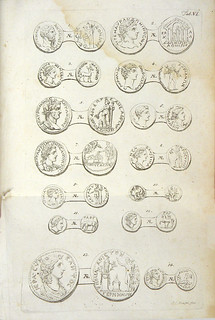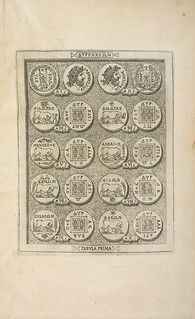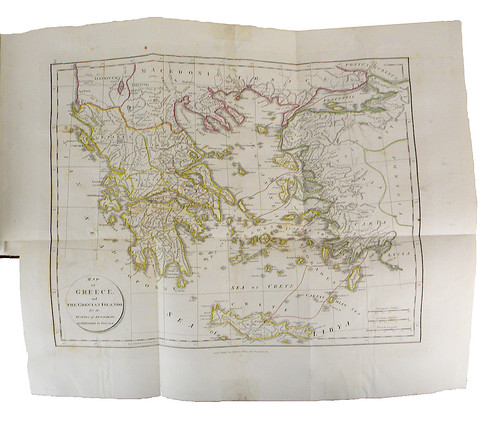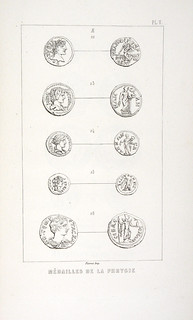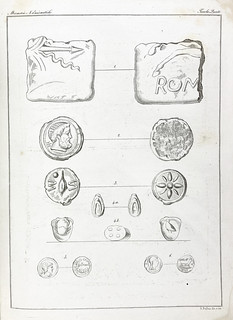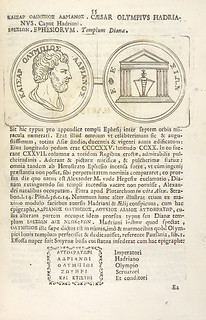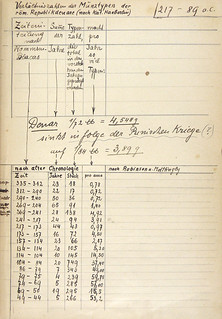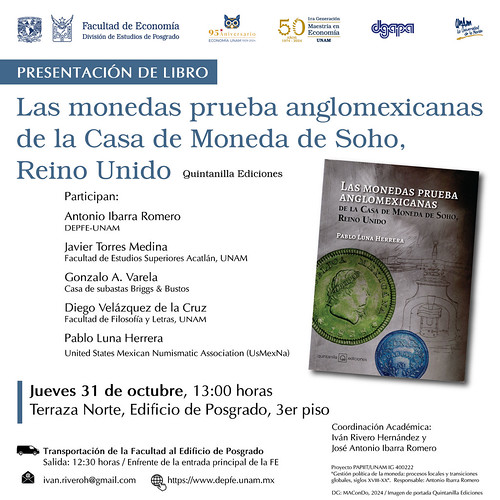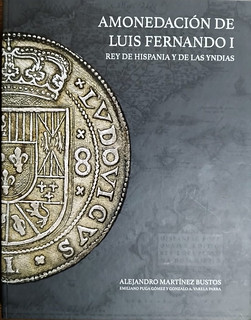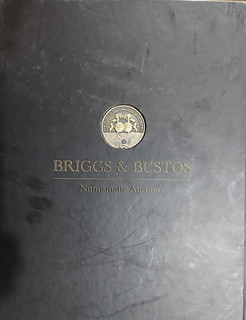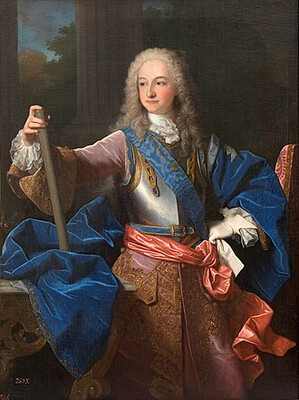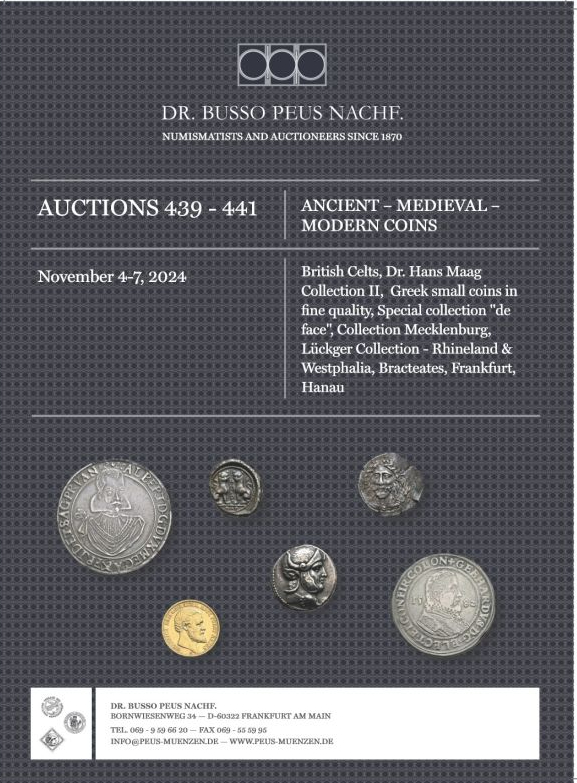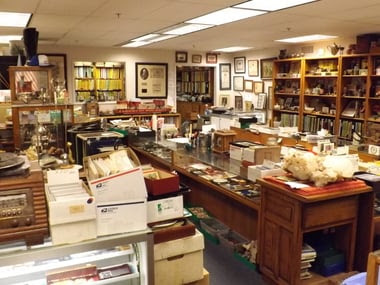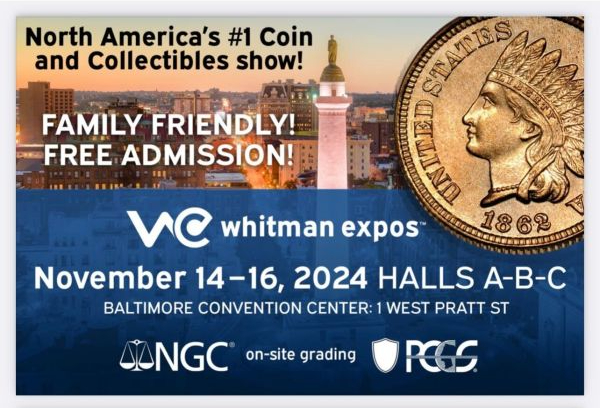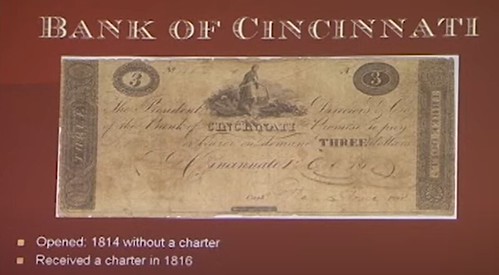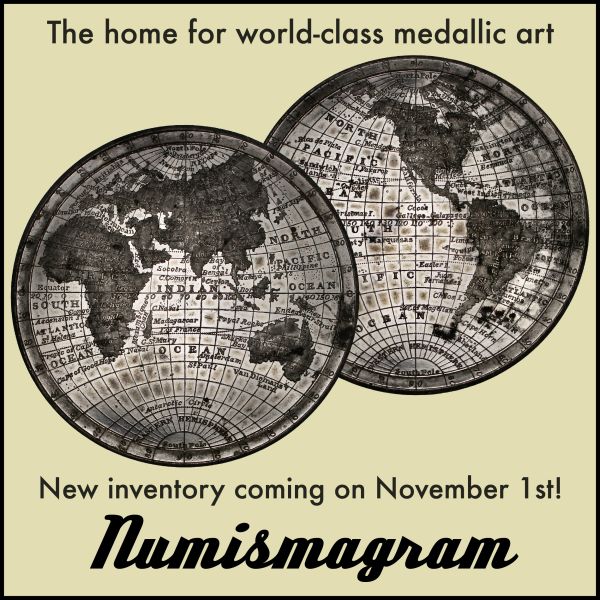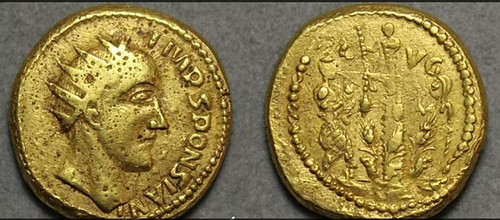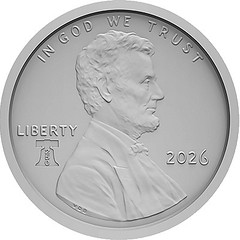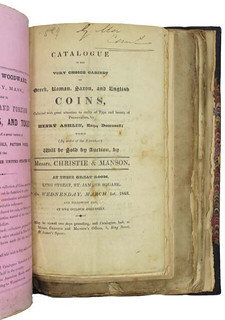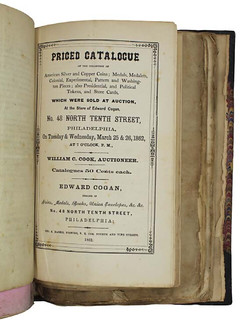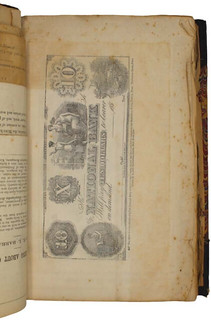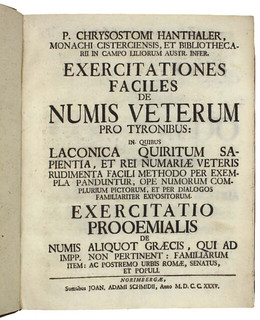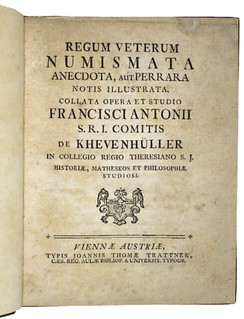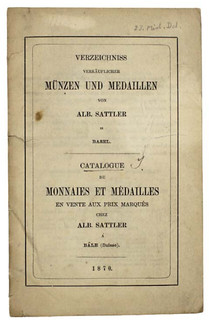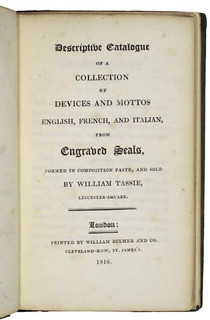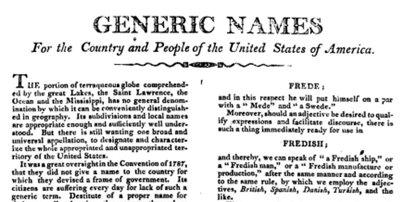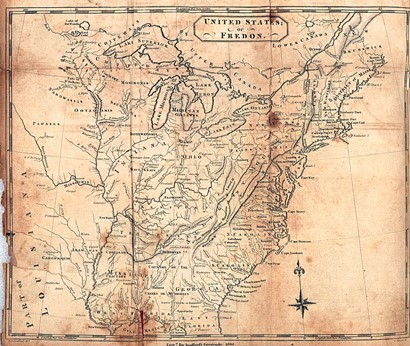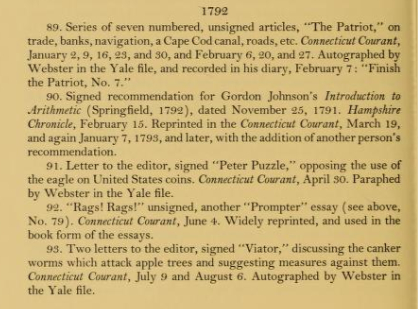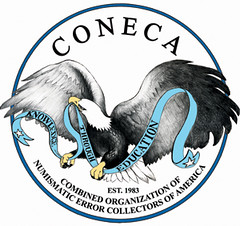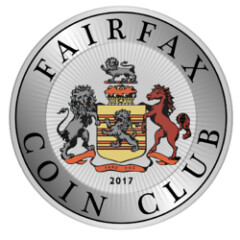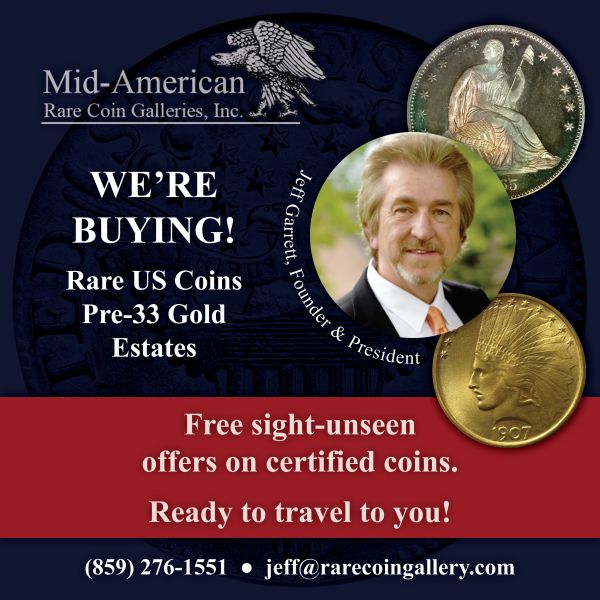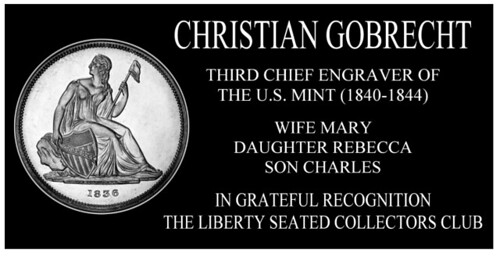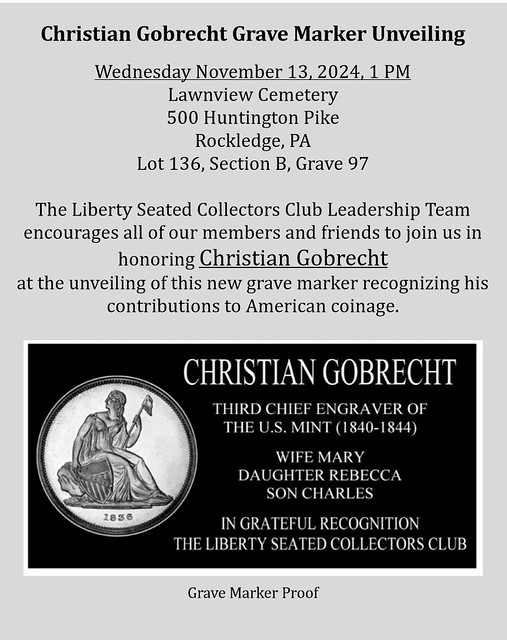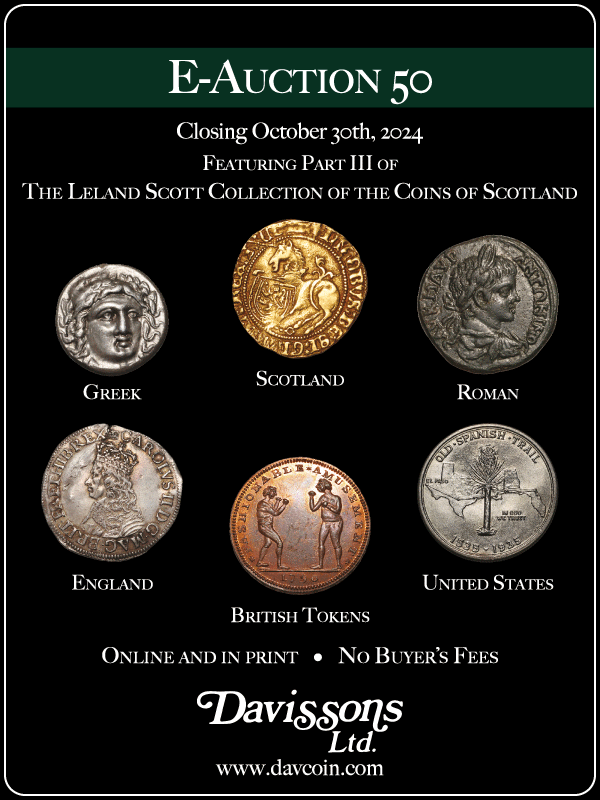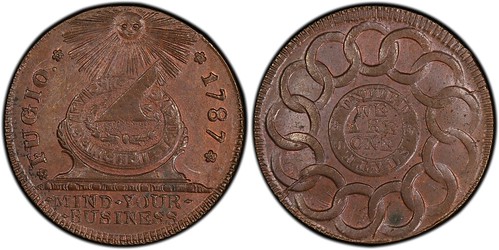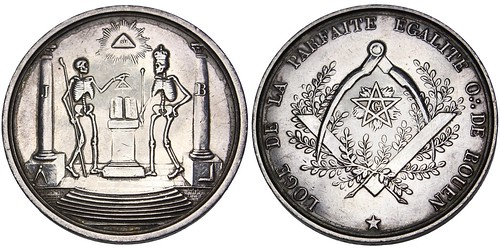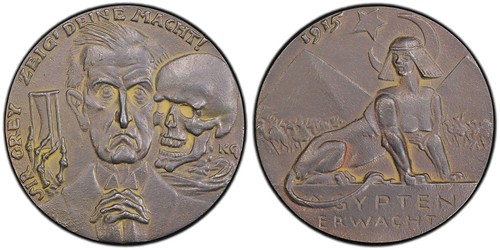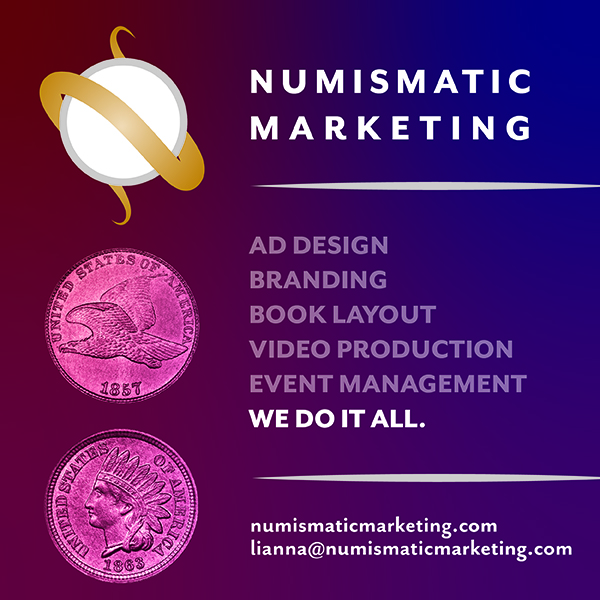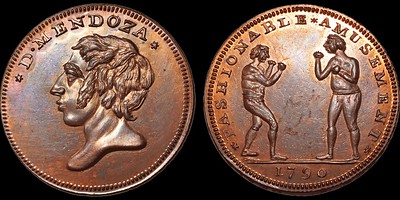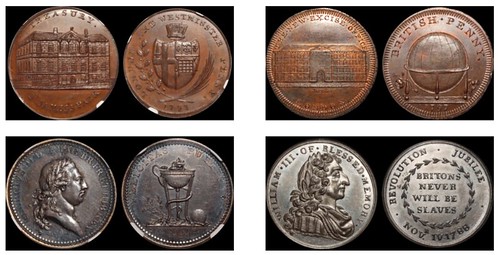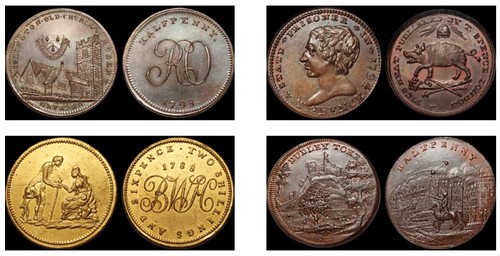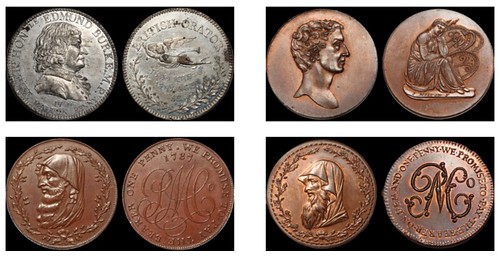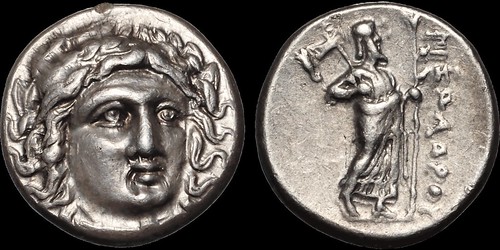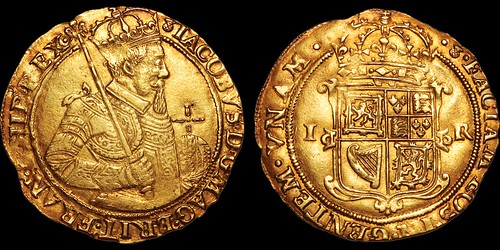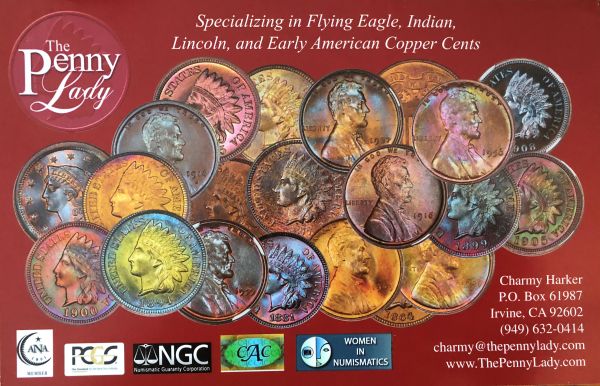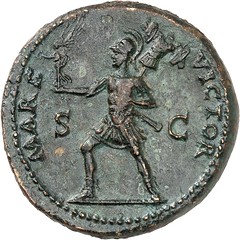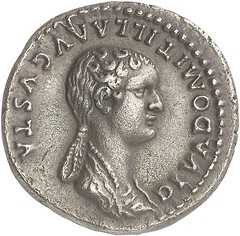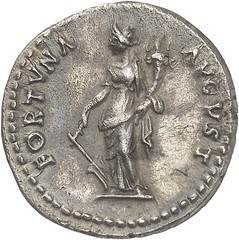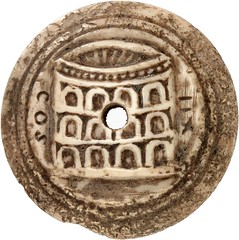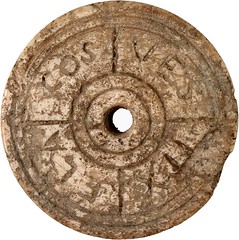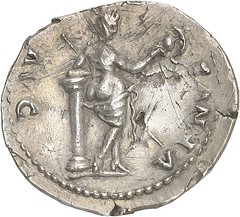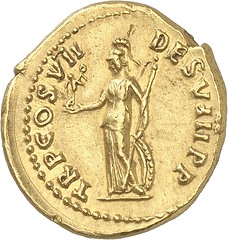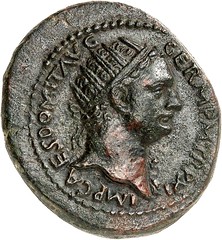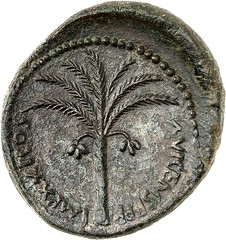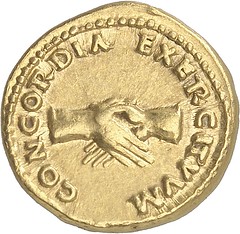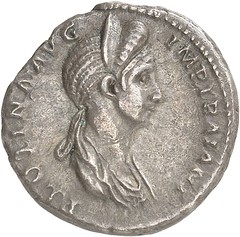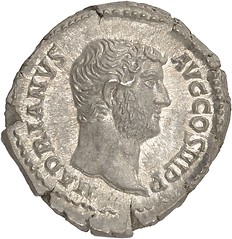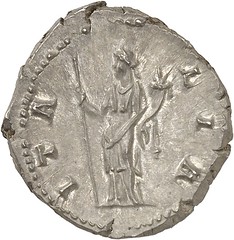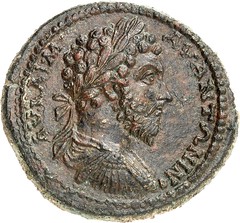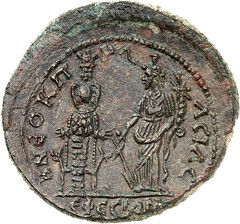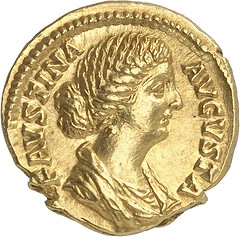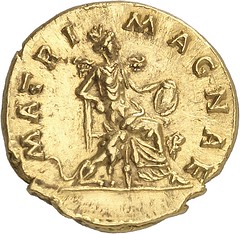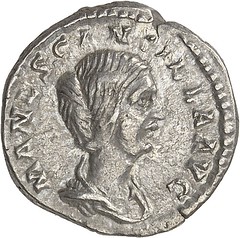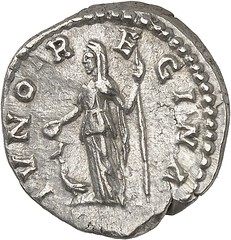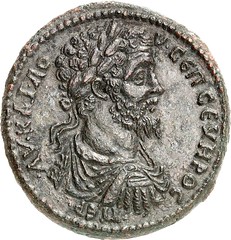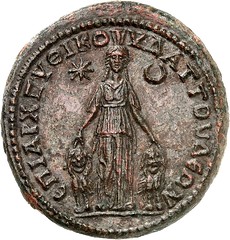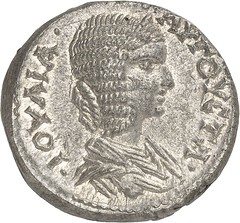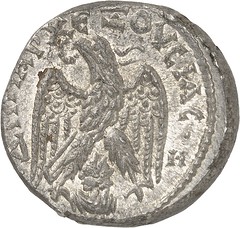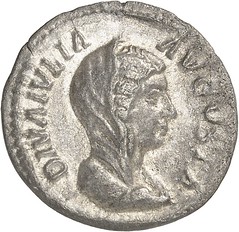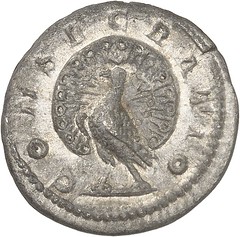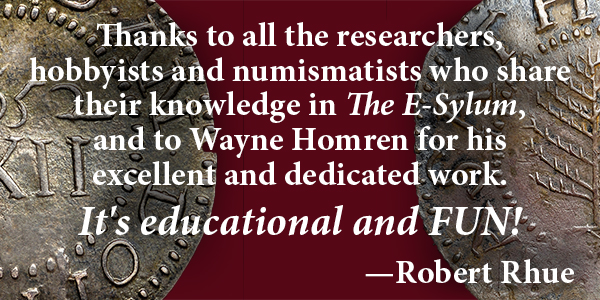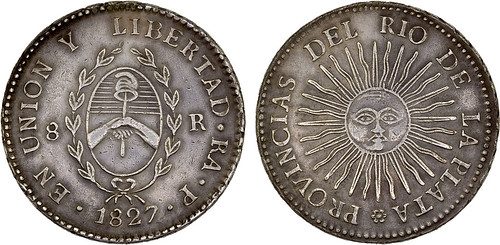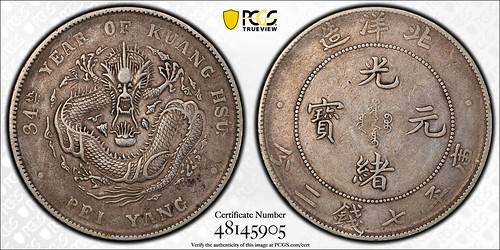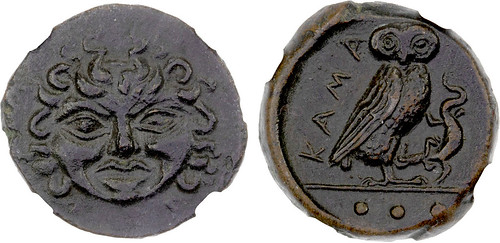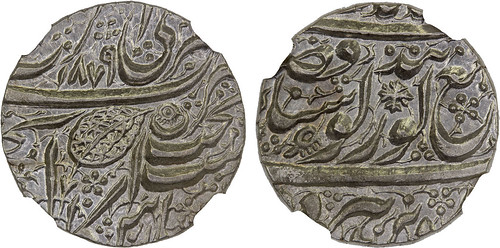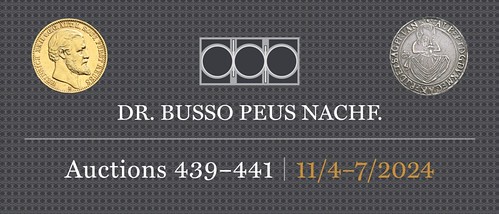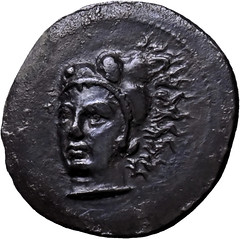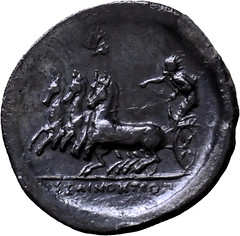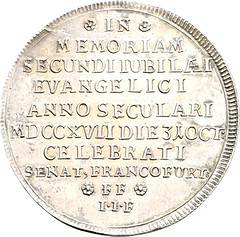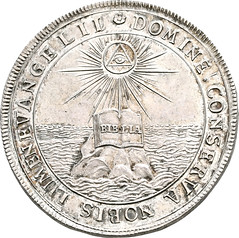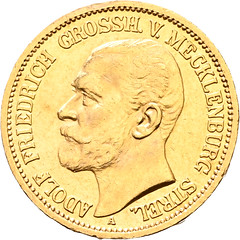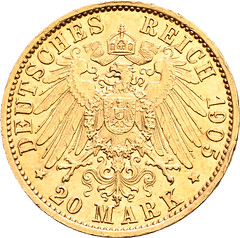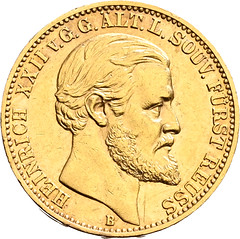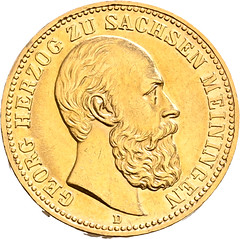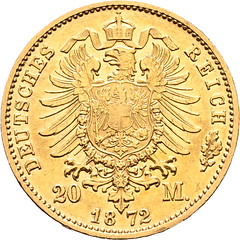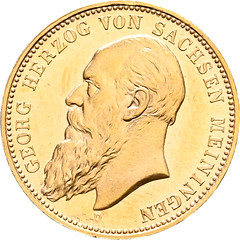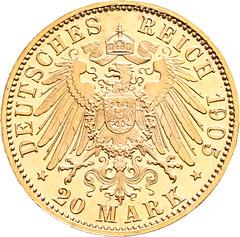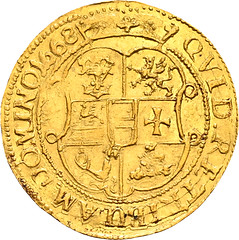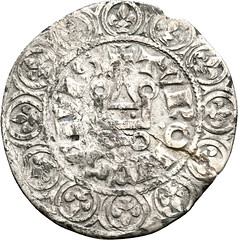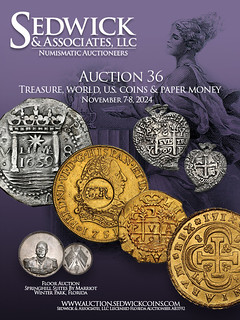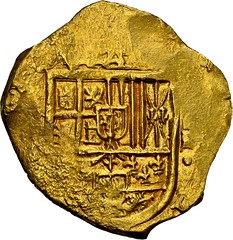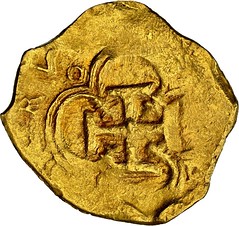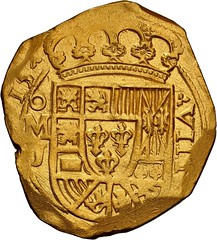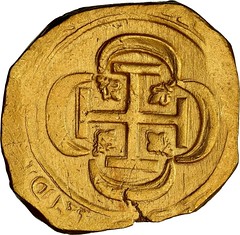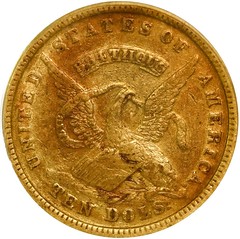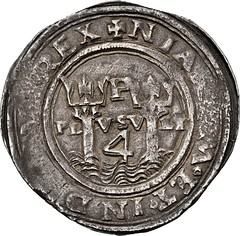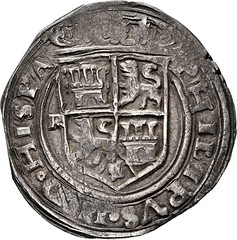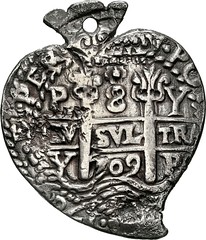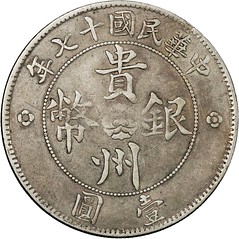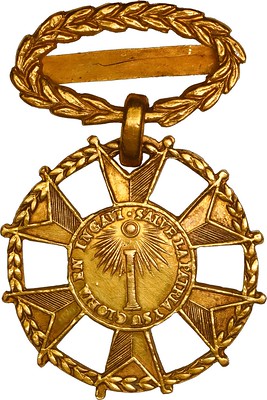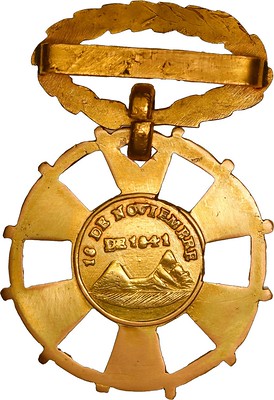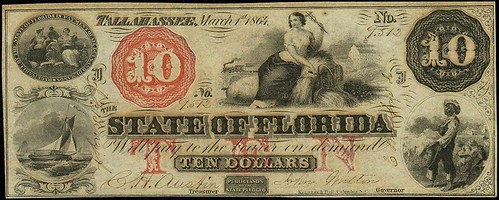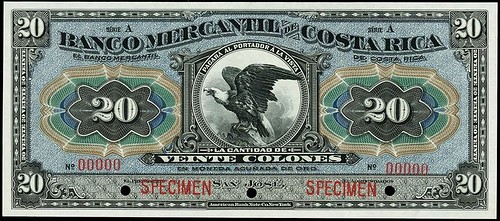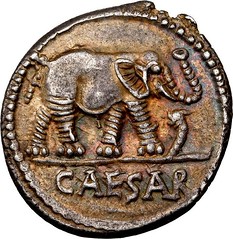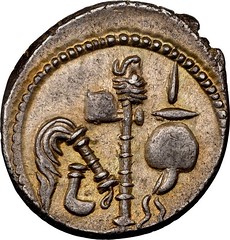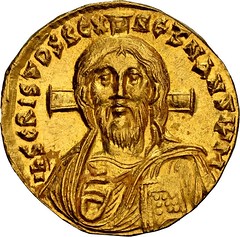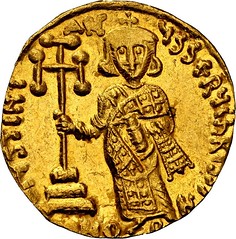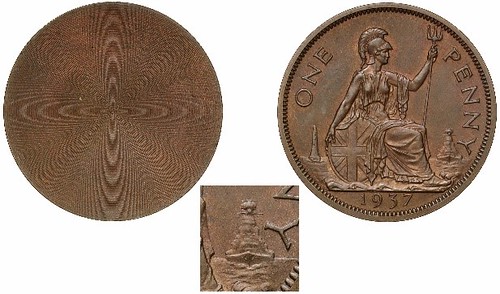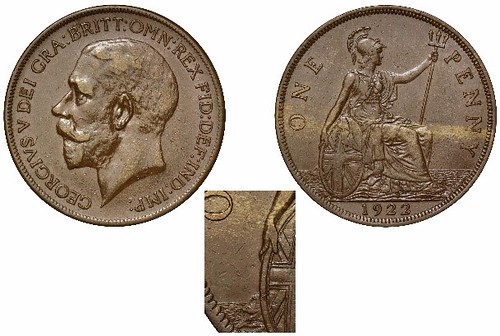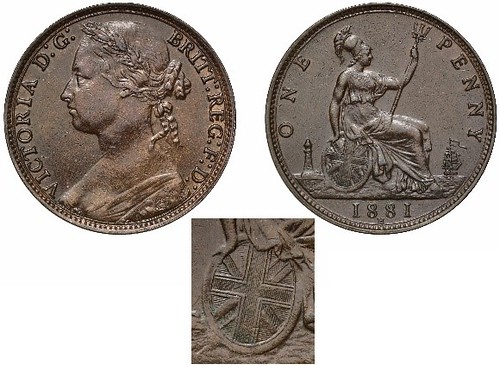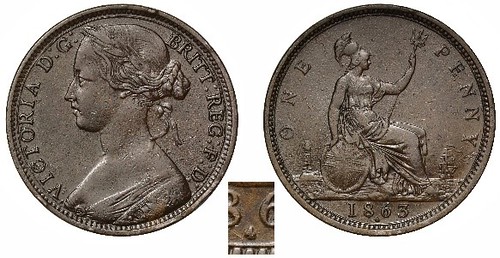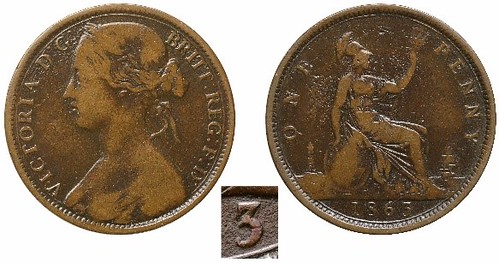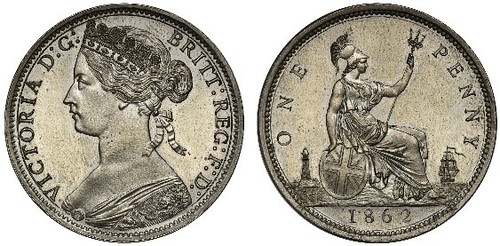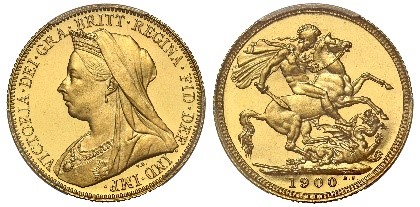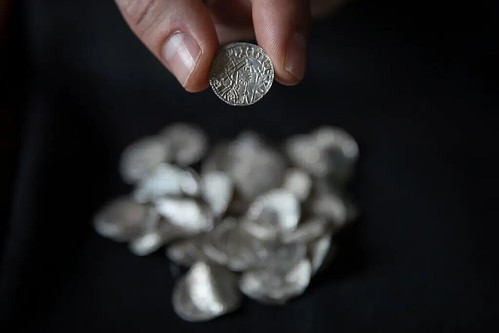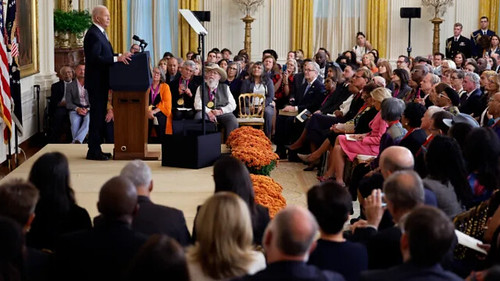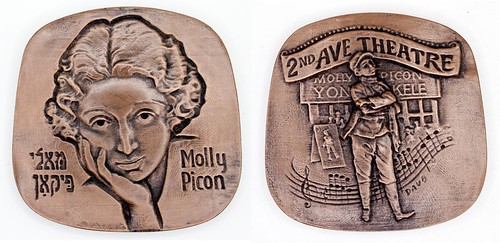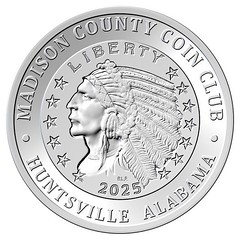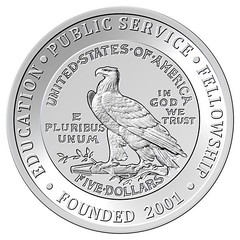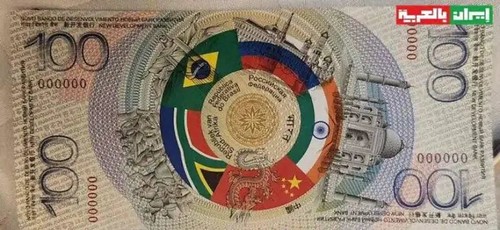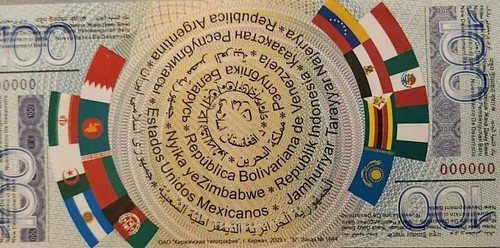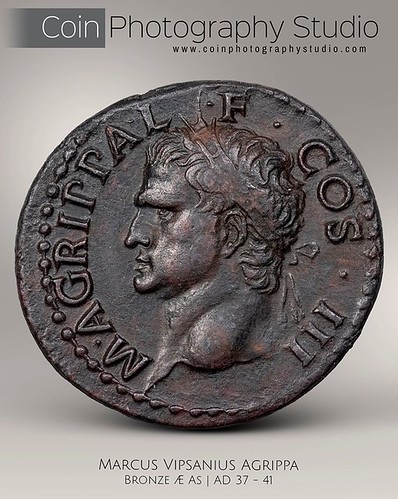
Visit our NBS Sponsors
About UsThe Numismatic Bibliomania Society is a non-profit association devoted to the study and enjoyment of numismatic literature. For more information please see our web site at coinbooks.org SubscriptionsThose wishing to become new E-Sylum subscribers (or wishing to Unsubscribe) can go to the following web page link MembershipThere is a membership application available on the web site Membership Application To join, print the application and return it with your check to the address printed on the application. Print/Digital membership is $40 to addresses in the U.S., and $60 elsewhere. A digital-only membership is available for $25. For those without web access, write to: Jeff Dickerson, Treasurer AsylumFor Asylum mailing address changes and other membership questions, contact Jeff at this email address: treasurer@coinbooks.org SubmissionsTo submit items for publication in The E-Sylum, write to the Editor at this address: whomren@gmail.com BUY THE BOOK BEFORE THE COINSale Calendar
|
- WAYNE'S WORDS: THE E-SYLUM OCTOBER 27, 2024
- K&F BCD LIBRARY SALE, PART 2 HIGHLIGHTS
- NEW BOOK: ANGLO-MEXICAN PROOF COINS
- NEW BOOK: COINAGE OF LOUIS FERDINAND I
- NEW BOOK: J.D. BOWMAN COLLECTION OF CHOPMARKED COINS
- NEW BOOK: ED MURPHY COLLECTION OF CHOPMARKED COINS
- PERIODICAL: ERRORSCOPE NOV/DEC 2024
- RICHARD ARNOLD ELIASBERG (1931-2024)
- JOHNNY HARRY HELEVA (1951-2024)
- SAMPLE SLAB COLLECTORS RENEW NEWSLETTER
- VIDEO: ANTEBELLUM BANKING IN CINCINNATI
- ACEF JOINS SHOP SAFE ACT COALITION
- NOTES FROM E-SYLUM READERS: OCTOBER 27, 2024
- SAMUEL MITCHILL AND THE MODEL FOR LIBERTY
- NOAH WEBSTER DECRIES PLANS FOR U.S. COINS
- FAIRFAX CLUB HOSTS ERROR COIN SPEAKER
- CHRISTIAN GOBRECHT GRAVE MARKER
- 2024 C4 CONVENTION EDUCATIONAL PROGRAMS
- VOCABULARY TERM: PROOF FINISH, PART 1
- FREDERICK HERBERT LAKOSKY (1894-1968)
- KELLEN HOARD INTERVIEW, PART THREE
- NUMISMAGRAM MEDAL SELECTIONS: OCTOBER 27, 2024
- DAVISSONS E-AUCTION 50
- KUENKER AUCTION 417
- STEPHEN ALBUM INTERNET AUCTION 29
- DR. BUSSO PEUS NACHF. AUCTION 439
- DR. BUSSO PEUS NACHF. AUCTIONS 440-441
- SEDWICK TREASURE AUCTION 36
- SOVEREIGN RARITIES WORKMAN COLLECTION, PART 2
- THE CHEW VALLEY HOARD
- BIDEN AWARDS NATIONAL ARTS MEDALS
- JEWISH-AMERICAN MEDAL SERIES REBOOTS
- 2025 MADISON COUNTY COIN CLUB MEDAL
- THE NEW BRICS FANTASY NOTE
- FEATURED WEBSITE: COIN PHOTOGRAPHY STUDIO
Content presented in The E-Sylum is not necessarily researched or independently fact-checked, and views expressed do not necessarily represent those of the Numismatic Bibliomania Society.
WAYNE'S WORDS: THE E-SYLUM OCTOBER 27, 2024
 New subscribers this week include:
Jeff Pritchard.
Welcome aboard! We now have 7,266 subscribers.
New subscribers this week include:
Jeff Pritchard.
Welcome aboard! We now have 7,266 subscribers.
Thank you for reading The E-Sylum. If you enjoy it, please send me the email addresses of friends you think may enjoy it as well and I'll send them a subscription. Contact me at whomren@gmail.com anytime regarding your subscription, or questions, comments or suggestions about our content.
This week we open with a numismatic literature sale, four new books and a periodical issue, updates from the Newman Numismatic Portal, two obituaries, and more.
Other topics this week include chopmarked coins, error coins, sample slabs, the rumored model for Liberty on early U.S. coins, U. S. Mint engraver Christian Gobrecht, collectors Fred Lakosky and Kellen Hoard, fixed price and auction previews, the Chew Valley hoard, the National Medals of Arts and Humanities, the Jewish-American Hall of Fame Medal series, and the new BRICS fantasy note.
To learn more about Anglo-Mexican proof coins from the Soho Mint, the coinage of Louis Ferdinand I, King of Spain and the West Indies, Richard Eliasberg, Johnny Heleva, early banking in Cincinnati, Sponsianus the Spewer, Civil War cardboard scrip, Fugio Cents, the Awakening of Egypt medal, tetragrammatons and suzerainty, read on. Have a great week, everyone!
Wayne Homren
Editor, The E-Sylum
K&F BCD LIBRARY SALE, PART 2 HIGHLIGHTS
Here's a reminder and final group of highlights from the upcoming second sale of the BCD Library of ancient numismatics. -Editor
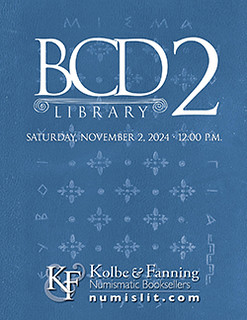 Kolbe & Fanning Numismatic Booksellers are looking forward to our second BCD Library sale, which will be held on Saturday, November 2. The online catalogue can be accessed at
bid.numislit.com. and bidders from around the world have already begun placing bids in what promises to be another exciting sale from the most extraordinary private collection of material on the coinage of antiquity that we have ever handled. The sale features classic references, modern die studies of individual cities, descriptive catalogues of important collections, and much more.
Kolbe & Fanning Numismatic Booksellers are looking forward to our second BCD Library sale, which will be held on Saturday, November 2. The online catalogue can be accessed at
bid.numislit.com. and bidders from around the world have already begun placing bids in what promises to be another exciting sale from the most extraordinary private collection of material on the coinage of antiquity that we have ever handled. The sale features classic references, modern die studies of individual cities, descriptive catalogues of important collections, and much more.
Some highlights of this sale include:
Lot 245: Domenico Sestini's 1796 compendium of ancient coins in many of the finest collections of the day, including those of Ainslie, Bellini, Bondacca and others
Lot 254: four of the catalogues of the massive collection formed by Christian Jürgensen Thomsen, including both catalogues devoted to ancient coins
Lot 315: Johannes Weidner's rare 1694 study, Pietas ex nummis antiquioribus delineata, on the concept of pietas in ancient coinage
Lot 330: a 1708 folio edition of Hubertus Goltzius's hugely influential volume on the coinage of mainland Greece, the islands, and Asia Minor, in a contemporary binding
Lot 322: an attractive copy of the 1825 edition of the Maps, Plans, Views and Coins, Illustrative of the Travels of Anacharsis the Younger in Greece
Lot 429: W.H. Waddington's 1853 Voyage en Asie-Mineure au point de vue numismatique, a truly charming work that is rarely encountered
Lot 466: Demetrio Diamilla-Müller's 1853 Memorie numismatiche, a rare collection of essays and excerpts on numismatic topics, primarily on Roman coins
Lot 467: the second edition (1683) of Charles Patin's catalogue of the collection of Pietro Mauroceni, a senator at Venice who had given his collection to the state
Lot 468: a remarkable copy of Friedrich Stefan's 1932 Münzkunde des Altertums, extensively annotated by Dr. August Voirol
Lot 475: Jacob Oisel's 1677 Thesaurus selectorum numismatum antiquorum, with 118 finely engraved plates that are crisply printed in this copy.
Register early to bid online
Bids may be placed via post, email, phone, as well as online. Kolbe & Fanning use Auction Mobility as our third-party online bidding platform. Auction Mobility is an app-based platform allowing users the ability to participate in the sale through phones, tablets and computers. To register for the sale, bidders must go to
bid.numislit.com and sign up. Once you have set up an account, you may browse lots, place advance bids, or participate in the live sale online. Those wishing to participate on their devices can download the Kolbe & Fanning app through the Apple or Google Play Store. The sale has also been listed on Biddr, NumisBids, and Numis24.
The printed catalogue has been mailed to all active customers on our mailing list. As international mail speeds have been inconsistent, we encourage our foreign clients to consult the electronic catalogue in case their printed catalogue does not arrive promptly. A PDF of the printed catalogue has been posted to our main website at numislit.com for those who prefer that format. Bids placed via post, email, or phone must be received by November 1, the day before the sale, in order for them to be processed. Advance absentee bids may also be placed at any time online at bid.numislit.com. Internet bidding will be available during the sale itself through the same platform.
Kolbe & Fanning Numismatic Booksellers LLC is a licensed and bonded auction firm in the State of Ohio, and our auctions are conducted by licensed auctioneers. For more information, please see the Kolbe & Fanning website at numislit.com or email David Fanning at df@numislit.com. To register for the sale, go to bid.numislit.com. We look forward to your participation.
To read the earlier E-Sylum articles, see:
KOLBE & FANNING BCD LIBRARY SALE, PART 2
(https://www.coinbooks.org/v27/esylum_v27n40a02.html)
K&F BCD LIBRARY SALE, PART 2 HIGHLIGHTS
(https://www.coinbooks.org/v27/esylum_v27n41a04.html)
K&F BCD LIBRARY SALE, PART 2 HIGHLIGHTS
(https://www.coinbooks.org/v27/esylum_v27n42a03.html)
NEW BOOK: ANGLO-MEXICAN PROOF COINS
Pablo Luna Herrera has published a book on the Anglo-Mexican proof coins from the Soho Mint. -Editor
Las monedas prueba anglomexicanas de la Casa de Moneda de Soho, Reino Unido
Anglo-Mexican proof coins from the Soho Mint, UK
Author: Luna Herrera, Pablo Rodolfo
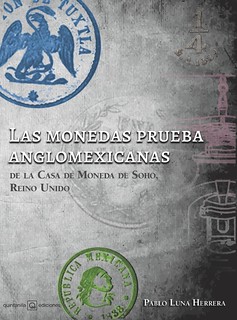 Publisher: Quintanilla Rodríguez María de los Dolores Francisca
Publisher: Quintanilla Rodríguez María de los Dolores Francisca
Subject: Numismatics and sigillography
Target audience: General
Published: 2022-10-30
Edition number: 1
Number of pages: 208
Size: 17x23cm.
Price: $300
Binding: Softcover or paperback
Support: Printed
Language: Spanish
ISBN 978-607-8801-41-1
Pablo Luna Herrera's research addresses a problem that crosses several themes, to give a possible answer to the existence of proof-type coins produced in England at the Soho mint, Birmingham, between 1828 and 1838 for the mints of Mexico, challenging the regulation regarding the forms of production existing in this country in the 19th century, achieving a finer coin, but also challenging the provision that the coins, like the proofs, were made in Mexico.
There are three different ways to purchase the book:
1. In the United States, the book can be purchased from World Numismatics' online store:
https://worldnumismatics.com/product/the-mexican-pattern-coin-cuartillas-by-pable-luna-herrara/
2. In Mexico, (international shipping is available) from Briggs & Bustos, auction house:
https://www.bbauctions.com.mx/shop-detail1.html
3. The book will be presented and discussed with experts in the field at a personal event in Mexico City on Thursday, October 31. Please see the attached poster for details. The book will be available for purchase.
Pablo adds:
"The book was originally published and presented in February 2023. However, due to the high level of interest and requests, and for an invitation that I received from the most important university in Mexico, I will be holding a second presentation. If you would like to view the video of the initial presentation, See the link below. Please note that the video is in Spanish."
To watch the video, see:
Presentación de libro Las Monedas Prueba Anglomexicanas de la casa de moneda de Soho Reino Unido
(https://youtu.be/ng7uw1qzB9M)
For more information, see:
Anglo-Mexican proof coins from the Soho Mint, UK
(https://isbnmexico.indautor.cerlalc.org/catalogo.php?mode=detalle&nt=377351)
To read the earlier E-Sylum article, see:
NEW BOOK: THE MEXICAN PATTERN COIN CUARTILLAS
(https://www.coinbooks.org/v26/esylum_v26n12a03.html)
NEW BOOK: COINAGE OF LOUIS FERDINAND I
Adrián González-Salinas passed along this information about a new book on the coinage of Louis Ferdinand I, King of Spain and the West Indies. Thank you. -Editor
Amonedación de Luis Fernando I Rey de Hispania y de las Yndias
(Coinage of Louis Ferdinand I King of Spain and the West Indies)
Authors: Alejandro Martínez-Bustos, Emiliano Puga-Gómez & Gonzalo A. Varela-Parra
First Edition (April 2024)
Copies: 300
Pages: (3), (VI), (5), 186
WxHxT: 22.7 x 28.8 x 2 cms
Binding: Hardcover
Language: Spanish
Printer: Full Graphics, Mexico
Price: US$175
 This is an specialized guide of the coinage of King Louis I struck under his name in the mints of Spain (Mallorca, Madrid, Segovia, Seville) and Latin America (Lima, Mexico City, Potosí and Santa Fe).
This is an specialized guide of the coinage of King Louis I struck under his name in the mints of Spain (Mallorca, Madrid, Segovia, Seville) and Latin America (Lima, Mexico City, Potosí and Santa Fe).
The back cover contains a 38 mm plaque struck by Fidias Arte (Mexico City) and related to Louis I with the legend: "Por Pedro Avilés y El Gremio de Plateros" (By Pedro Avilés and The Silversmiths' Guild).
It's a deluxe book in full color focused on the Spanish Colonial Empire numismatic collector and highly recommended.
- Chapter I - Mints of Mallorca, Madrid, Segovia and Seville
- Chapter II - Mint of Lima (Peru)
- Chapter III - Mint of Mexico
- Chapter IV - Mint of Potosí (Bolivia)
- Chapter V - Mint of Santa Fe (Colombia)
- Resellos sobre Monedas de Luis I (Counterstamps on Louis I coins)
- Catálogo Reducido (Summarized Catalog)
For more information, or to order, see:
Coinage of Luis Fernando I – King of Hispania and the Indies
(https://www.bbauctions.com.mx/shop-detail3.html)
Email: admin@bbauctions.com.mx
See also:
Presentación del Libro - Amonedación de Luis Fernando I Rey de Hispania y de las Yndias
(https://www.youtube.com/watch?v=TU9ZKiQm8IE)
Amonedación de Luis Fernando I | Alejandro Martínez Bustos | Madrid 2024
(https://www.youtube.com/watch?v=K7PbospxVUg)
NEW BOOK: J.D. BOWMAN COLLECTION OF CHOPMARKED COINS
A new book on chopmarked coins was published this week. -Editor
The Catalog of the J.D. Bowman Collection of Chopmarked Coins
(The Chopmark Reference Series)
by Mr. William Taylor Leverage and Mr. Dan Huntsinger
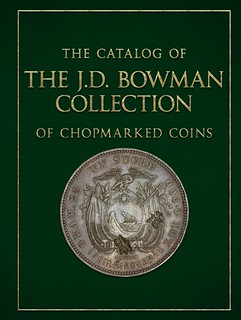 Most chopmark collections assembled in the past have been broken apart without fanfare, even those that represent decades of dedicated effort. In retrospect, this isn't much of a surprise - chopmarked coins have been an awkward niche in the world of numismatics for years, and prices have remained low until relatively recently. Recent years have seen a rise in interest in chopmarks, but important earlier collections typically can't be recorded after they have be broken apart; the J.D. Bowman Collection represents one of the few instances where enough information is available that the set can be 'pieced together' retroactively, using a combination of the collector's own notes and more recent auction appearances.
Most chopmark collections assembled in the past have been broken apart without fanfare, even those that represent decades of dedicated effort. In retrospect, this isn't much of a surprise - chopmarked coins have been an awkward niche in the world of numismatics for years, and prices have remained low until relatively recently. Recent years have seen a rise in interest in chopmarks, but important earlier collections typically can't be recorded after they have be broken apart; the J.D. Bowman Collection represents one of the few instances where enough information is available that the set can be 'pieced together' retroactively, using a combination of the collector's own notes and more recent auction appearances.
The Bowman Collection was primarily assembled between 1984 and 1994, with a large proportion recorded in a series of handwritten inventories submitted to The Chopmark News; scans of these inventories form the basis for the catalog, including not only nationalities, dates, and denominations, but descriptions and drawings of specific chops. These detailed descriptions have allowed for specific coins to be attributed to the Bowman Collection as they have appeared on the secondary retail market and the auction circuit between 2016 and the present, even without any images from the original collection; more recent auction details and collector provenances are recorded where relevant. Additionally, more than 50 pieces traced back to Bowman have been photographed and are included in the catalog, including many key rarities.
Please note that this catalog is not an introduction to the historical background of chopmarks, but should be considered reference material primarily intended for provenance research. However, the size of the collection and the presence of a number of rare pieces make the catalog a worthy addition to any chopmark collector's library.
Publishe : Independently published (October 22, 2024)
Language English
Hardcover : 187 pages
ISBN-13 : 979-8344039435
Reading age : 14 - 18 years
Item Weight : 1.2 pounds
Dimensions : 8.25 x 0.63 x 11 inches
For more information, or to order, see:
The Catalog of the J.D. Bowman Collection of Chopmarked Coins (The Chopmark Reference Series)
(https://www.amazon.com/Catalog-Collection-Chopmarked-Chopmark-Reference/dp/B0DKJYM255/)
NEW BOOK: ED MURPHY COLLECTION OF CHOPMARKED COINS
Another book in the Chopmark Reference Series was published last year, but we haven't discussed it before. -Editor
The Catalog of the Ed Murphy Collection of Chopmarked Coins
(The Chopmark Reference Series)
by James Wemmick
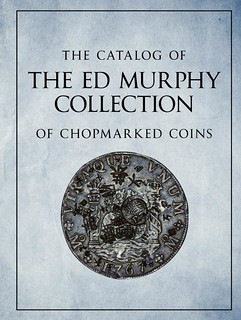 Until relatively recently, chopmarked coins - currency countermarked by merchants in China and nearby regions, typically to confirm silver content - were thought to be damaged or at best, curiosities. Few pieces were considered important enough to be included in well-known numismatic collections, and fewer still were plated in public references. As a result, many chopmarked coins have lost their provenances with time; there are no comprehensive visual records of important chopmark collections such as those assembled by F. M. Rose and Hal Walls, apart from scattered pieces that were given pride of place in numismatic references or auction catalogs.
Until relatively recently, chopmarked coins - currency countermarked by merchants in China and nearby regions, typically to confirm silver content - were thought to be damaged or at best, curiosities. Few pieces were considered important enough to be included in well-known numismatic collections, and fewer still were plated in public references. As a result, many chopmarked coins have lost their provenances with time; there are no comprehensive visual records of important chopmark collections such as those assembled by F. M. Rose and Hal Walls, apart from scattered pieces that were given pride of place in numismatic references or auction catalogs.
The Ed Murphy Collection, assembled over several decades through dealers in the Philippines and through the American auction circuit, is one of the largest collections of its kind ever assembled. Meticulously photographed and incorporating Mr. Murphy's personal attributions, the catalog is intended to showcase one collector's particular interpretation of what constitutes a chopmark, and to provide an ironclad provenance for future collectors conducting background research on specific pieces. The Murphy Collection's particular strength is the comprehensive range of its host types, representing over 500 crowns, minors, and contemporary counterfeits constituting several hundred years, each of which is illustrated.
Note that while the range of types is exceptional, the catalog provides little context for each piece or for chopmarks as a whole, and as such should be considered advanced reference material rather than an introductory guide to new collectors entering the chopmark collecting space.
Publisher : Independently published (November 5, 2023)
Language : English
Hardcover : 271 pages
ISBN-13 : 979-8864194379
Item Weight : 1.69 pounds
Dimensions : 8.25 x 0.83 x 11 inches
For more information, or to order, see:
The Catalog of the Ed Murphy Collection of Chopmarked Coins (The Chopmark Reference Series)
(https://www.amazon.com/gp/product/B0CMQGQZLN)
PERIODICAL: ERRORSCOPE NOV/DEC 2024
The Combined Organizations of Numismatic Error Collectors of America (CONECA) has published the latest issue of its magazine Errorscope. Here's the club's announcement. -Editor
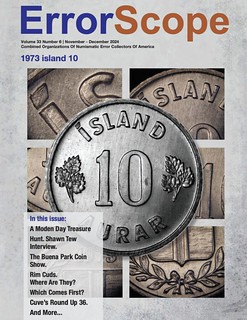 CONECA has released its November/December 2024 issue of its long-running magazine Errorscope
featuring articles and photos on error and variety coins. The magazine comes out every two months
and for its upcoming December 1st 2024 deadline for the January/February 2025 issue, the club is
seeking contributions from collectors about error and variety coins.
CONECA has released its November/December 2024 issue of its long-running magazine Errorscope
featuring articles and photos on error and variety coins. The magazine comes out every two months
and for its upcoming December 1st 2024 deadline for the January/February 2025 issue, the club is
seeking contributions from collectors about error and variety coins.
This issue features articles on foreign error coins, an interview with researcher Shawn Tew about recent discoveries around 1910 cents and their reverses, information about the Buena Park Coin Show, and other articles on various error and variety topics.
Collectors interested in contributing articles can submit their ideas to minterrors@gmail.com for consideration by the club officers responsible for the magazine.
Education is a main goal of CONECA and Errorscope which has been in publication in various forms for decades, is a principal vehicle for communicating ideas, interviews, trends, and information about the error and variety hobby. Collectors of all areas of interest are welcome to join the club and to contribute stories and articles to the magazine. Past articles have covered ancient coin errors, modern coin show finds, foreign varieties, collecting trends, and more.
To be a contributor to Errorscope, authors need not be club members, though membership is always invited, available, and welcomed!
CONECA, with membership information, can be found online at https://conecaonline.org
The club, whose name stands for "Combined Organizations of Numismatic Error Collectors of America," is the largest coin specialty club in the United States and has actively been educating collectors about mint error and variety coins for the last five decades. Its members span collecting areas of interest from all areas of the minting process, from planchet, die, and striking errors, to varieties across all series of United States and foreign coinage.
RICHARD ARNOLD ELIASBERG (1931-2024)
Richard Eliasberg recently passed; he was the son of Baltimore's mega-collector Louis E. Eliasberg, Sr. -Editor
 On October 12, 2024, Richard Arnold Eliasberg, a resident of Admirals Cove in Jupiter, Florida, passed away from cancer at 92 years of age. He was born in Baltimore, Maryland; attended Baltimore City College and the University of Pennsylvania, graduating from the Wharton School in 1953; and served in the U. S. Navy, completing his service as a Lieutenant J.G. in 1955.
On October 12, 2024, Richard Arnold Eliasberg, a resident of Admirals Cove in Jupiter, Florida, passed away from cancer at 92 years of age. He was born in Baltimore, Maryland; attended Baltimore City College and the University of Pennsylvania, graduating from the Wharton School in 1953; and served in the U. S. Navy, completing his service as a Lieutenant J.G. in 1955.
After briefly working as an insurance agent for Travelers Insurance Company at the Jerome Apple Agency, he helped found First Federated Life Insurance Company where he served as President and Chief Executive Officer until its sale in July 1983. He served as President of Coastline Insurance Company and Coastline Reinsurance Company from their inception until 1983; was a Director of Maryland National Bank from 1974 to 1991 and also participated on its Executive and Audit Committees; served on the Board of Security Trust Company, a subsidiary of MNC Financial; and was a Director of the Finance Company of America.
Mr. Eliasberg founded the Eliasberg Family Foundation, Inc., and served as President and Trustee until just before his death. Additionally, he was a Trustee of the Maryland Academy of Sciences (and the Maryland Science Center) from 1973 to 1990, served as Chairman of the Board from 1985 to 1987, and was responsible for arranging the financing and construction of the IMAX Theater.
He served in various capacities – volunteer, Trustee, Chairman of the Board – of Mt. Washington Pediatric Hospital for over fifty years, serving as Chairman of the Board from 1977 to 1979, and also was a Trustee of North Arundel Health System, Inc.
Two literary accomplishments of Mr. Eliasberg were that he coauthored and published a history of Mt. Washington Pediatric Hospital entitled, Mt. Washington Pediatric Hospital: The First 100 Years; and he arranged for and was a contributing writer to the biography of his father entitled, Louis E. Eliasberg, Sr., King of Coins.
To read the complete article, see:
Richard Arnold Eliasberg 1931 - 2024
(https://www.legacy.com/us/obituaries/baltimoresun/name/richard-eliasberg-obituary?id=56538786)
Stack's Bowers Galleries Executive Vice President Christine Karstedt remembered Richard in a blog post this week. -Editor
It is with great sadness I say goodbye to a dear friend, Richard Eliasberg. For nearly 30 years we have had convivial dinners in Baltimore at our favorite restaurant, The Prime Rib. Sometimes we would invite friends and family, and everyone always had a marvelous time. Once a summer he would come to Wolfeboro, New Hampshire for his annual lobster roll and to catch up with Dave Bowers and me. I have always said that what I most appreciate about my job is the relationships I have built over the years, and my friendship with Richard has truly enhanced my life.
Richard lived a life of kindness, treating everyone he met with respect. He supported many Baltimore organizations and charities with his time and other contributions. He was a faithful steward of his father's incredible collection, dedicated to preserving his numismatic legacy. And that hair! I would recognize him across a crowded room just by seeing those thick, wavy locks.
Dave and I were just reminiscing about walking through that vault door featured on the cover of Life Magazine and using white gloves to remove the red wax seals on the display cases from the Smithsonian exhibit. It was amazing to see these treasures in hand for the first time after they had been locked away for decades. It was a highlight of my career in numismatics.
Richard had a consummate business mind and ethic mixed with a fabulous sense of humor and a passion to leave this world a better place. He will be sorely missed.
To read the complete article, see:
Richard A. Eliasberg
(https://stacksbowers.com/richard-a-eliasberg/)
JOHNNY HARRY HELEVA (1951-2024)
Dealer John Heleva passed away earlier this month. -Editor
Johnny Harry Heleva
December 7, 1951 ~ October 15, 2024 (age 72)
 We lost a notable man in the coin and currency business today. John Heleva of Sacramento, California, felt like a lucky man because he was always employed at something he loved - the coin business. He died peacefully in his sleep, something we all hope for. Johns family was in Sacramento 165 years. His wife, Dawn was born there. He was born in Wiesbaden Germany 12/51. His father was active in the Berlin air lift.
We lost a notable man in the coin and currency business today. John Heleva of Sacramento, California, felt like a lucky man because he was always employed at something he loved - the coin business. He died peacefully in his sleep, something we all hope for. Johns family was in Sacramento 165 years. His wife, Dawn was born there. He was born in Wiesbaden Germany 12/51. His father was active in the Berlin air lift.
John's love affair with coins began when he was bedridden in a body cast from age 5-7 for a degenerative hip disorder called leg perthis. His grandfather would bring him bags of coins to sort from the bank and he got hooked. In high school he made spending money buying and selling silver. John started with paper money in his early twenties when he says you could not give bank notes away. He bought them cheap and watched it become a market. He loved history and that naturally played into his interest in coins and paper.
Those of us who knew and traded with him soon learned he was a veritable encyclopedia of knowledge. He could've easily written a book with his general collectible information.
John had two storefronts in Sacramento for some time and two warehouses. It took six trips in that old yellow truck, and an extra friend and driver that brought a big moving truck to get from California to Texas with most of the warehouse material.
John served as governor of the PDCA for a couple years. He left behind his wife, Dawn, three sons and one daughter, and several grandkids.
Fred Holabird published this remembrance of John in an October 18, 2024 email to clients. -Editor
Our friend John Heleva passed away silently in his sleep two days ago.
John was a mainstay at virtually every major coin show in America for about 50 years.
A native Californian, John grew up in a family that were entrepreneurial, buying and selling houses, collectibles and the like. His sister and mother were always heavily involved in the very early days, then John ventured into his own areas of sales, specializing in coins and collectibles. He was laser focused and quickly learned how to chase major collections.
I was one of the guys he chased, way back in the Miocene. He'd stay at my house and we'd discuss collections. I fed him plenty of discoveries over the years, and he returned the favor many times back in later years.
John understood the art of selling. He might attend a specialty trade show, such as the Strassburg, PA stock and bond show, where he'd show up two days ahead of time, set up shop in his motel room, open for business. Heck – if you weren't there two days ahead of time you'd miss out!
John was a riot at the big shows. You all knew him – he was "the guy" in the back of the show room with about five to fifteen tables, all completely full of stuff. Pretty much every area of numismatics – medals, tokens, and of course coins and paper money. Then there was the rare documents section, then the post card section, then the foreign coin section, then … well, you get the picture. A true salesman, he'd often be seen all over the show room, box in hand, heading to another dealer to offer out some goodies he knew they couldn't resist. With most of us whom he'd known for decades, doing business with John was a true pleasure. We got to set the prices. To this day, I don't think I've seen anybody else sell so much material at a trade show. …And you could be sure, there was more in the warehouse!
Meanwhile, back at his table area, in later years you got a chance to meet his son, who helped from time to time. Other times, especially in the East, his helper was Dave Strebe, another close friend of us all, and was "the guy" that scoured every flea market in the East.
John had a number of shops in the Sacramento area, moving from place to place as neighborhoods and shopping patterns changed. Recently he and Dawn moved to Texas, as have a lot of other California dealers. His plan was a slow retirement.
The next time you go to a major coin show, I hope there will be an empty table with his photo on it. He was a guy we'll all remember forever. And he was Your friend too!
To read the complete articles, see:
Johnny Harry Heleva
(https://www.azlefuneralhome.com/obituary/Johnny-Heleva)
https://www.instagram.com/vegascoinshow/p/DBLMycZRJTS/
SAMPLE SLAB COLLECTORS RENEW NEWSLETTER
The latest addition to the Newman Numismatic Portal is the latest issue of Sample Slab Update. Project Coordinator Len Augsburger provided the following report. -Editor
Sample Slab Collectors Renew Newsletter
 After a several year hiatus, the Sample Slab Update newsletter is back with the latest developments in the field of sample slab collecting. For the uninitiated, grading service companies often issue one-off variants of their encapsulating plastic holders, typically in conjunction with a specific coin show or other event. These special edition holders become collectible in themselves, in addition to the value of any coin contained therein. Further, slab types that were used for only a short time are desirable. The August 2024 edition of the Update notes, for example, the NGC type 8 holder ("The Ocho" in sample slab collector parlance), among other scarce types.
After a several year hiatus, the Sample Slab Update newsletter is back with the latest developments in the field of sample slab collecting. For the uninitiated, grading service companies often issue one-off variants of their encapsulating plastic holders, typically in conjunction with a specific coin show or other event. These special edition holders become collectible in themselves, in addition to the value of any coin contained therein. Further, slab types that were used for only a short time are desirable. The August 2024 edition of the Update notes, for example, the NGC type 8 holder ("The Ocho" in sample slab collector parlance), among other scarce types.
The Sample Slab Update is published by David Schwager, who naturally has commissioned his own sample slab. Produced by NGC, this slab commemorated the David and Michelle Schwager wedding in July 2024. Each holds a George VI silver sixpence issued between 1937 and 1946, chosen for the wedding rhyme that ends "and a sixpence in your shoe."
Image: David and Michelle Schwager wedding sample slab
Link to Sample Slab Update on Newman Portal:
https://nnp.wustl.edu/library/publisherdetail/514437
Link to YouTube video "NGC Gen 8 Holder - Not a Fake":
https://www.youtube.com/watch?v=afsluegtgiY
VIDEO: ANTEBELLUM BANKING IN CINCINNATI
The David Lisot Video Library on the Newman Numismatic Portal can be found at:
https://nnp.wustl.edu/library/multimediadetail/522852
We highlight one of his videos each week in The E-Sylum. Here's one with Wendell Wolka speaking on the story of early banking in Cincinnati and the bank notes that were issued. -Editor
Longtime paper money collector and ANA Governor Wendell Wolka shares the story of early banking in Cincinnati and the bank notes that were issued. In this lecture and Powerpoint presentation he shares:
- the history of Ohio
- three different eras of banking
- early banks including Bank of Cincinnati that failed four different times
- why so many banks failed
- different denominations
- counterfeit detector books to help people and institutions know what notes were being faked
- later banks going into the late 1850's
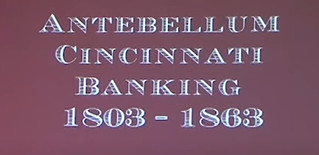
From the 2009 Central States Numismatic Society convention.
To watch the complete video, see:
Antebellum Banking in Cincinnati
(https://youtu.be/nNM33EqF_as)
ACEF JOINS SHOP SAFE ACT COALITION
This press release details the latest efforts of the Anti-Counterfeiting Educational Foundation (ACEF). -Editor
The Anti-Counterfeiting Educational Foundation (ACEF) has joined a national coalition comprised of more than 20 major industries seeking legislation to make e-commerce platforms responsible for ensuring that vendors on their platforms do not sell counterfeits products.
"Current U.S. laws and law enforcement's ‘whack-a-mole' approach have proven to be no match for the sellers of counterfeit products on e-commerce platforms. It's time to join forces and use our collective efforts to bring about the changes needed to shut down criminal access to the U.S. marketplace," said ACEF President John Albanese. "ACEF enthusiastically endorses the SHOP SAFE Act coalition's efforts and we pledge to inform and enlist the coin industry and numismatic collector community's support for this important mission," Albanese added.
SHOP SAFE is an acronym for "Stopping Harmful Offers on Platforms by Screening Against Fakes in E-Commerce."
The Shop Safe Act has bipartisan support in both the U.S. Senate and the House of Representatives. It received a public hearing in the Senate during the 118th Congress. However, it did not receive a floor vote in either chamber. Bipartisan sponsors have pledged to re-introduce bills in both chambers when the new Congress convenes in January 2025 and push to make the legislation become law in 2025.
Once enacted, the SHOP SAFE Act will require e-commerce platforms to engage in best practices for screening and vetting sellers and goods, address repeat counterfeiter sellers, and ensure that consumers have relevant information available to them, or the e-commerce platform could be held liable for the sale of counterfeit and illicit products that harm consumers.
The SHOP SAFE Act will be complementary to the INFORM Consumers Act that took effect on June 27, 2024. It requires online marketplaces to collect, verify, and disclose certain information about "high-volume third-party sellers." Coalition leaders note that together, these laws will begin to stem the influx of illicit products and safeguard consumers from the alarming dangers of counterfeits that extend across industries.
Kari Kammel, Director and Senior Academic Specialist, Center for Anti-Counterfeiting and Product Protection, at Michigan State University testified before a Senate subcommittee hearing Oct. 3., 2023, about the economic harm of counterfeit products.
Kammel noted: "The volume of counterfeits is staggering but also difficult to measure for a variety of reasons.
"First, itis an illicit activity that is often focused on deception.
"Second, the most accurate data we have is from seizure data. The U.S. Customs and Border Protection's Intellectual Property Rights Seizure Statistics report for the 2021 fiscal year reported that CBP had 102,490 seizures with an estimated manufacturer's suggested retail price (MSRP) of over $3.3 billion. The size of the problem is often calculated based on seizure data, or takedown data, which does not fully reflect the universe of counterfeit goods.
"Third, data sharing between brands, platforms, law enforcement, and academia has always been a struggle. However, despite these limitations, estimates of counterfeiting profits globally by Global Financial Integrity state that it is financially the largest criminal enterprise in the world, approximately $923 billion to $1.13 trillion a year—a higher amount than either drugs($426-652 billion) or human trafficking ($150.2 billion). Financially, counterfeit goods impact national economies; counterfeit and pirated goods in international trade have been estimated to amount to as much as USD464 billion in 2019, or 2.5% of world trade that year."
In addition to ACEF, the coalition is comprised of industry organizations such as the Alliance for Automotive Innovation, American Apparel & Footwear Association (AAFA), Association of Home Appliance Manufacturers (AHAM), Automotive Anti-Counterfeiting Council (A2C2), Communications Cable & Connectivity Association (CCCA), Consumer Healthcare Products Association (CHPA), Footwear Distributors & Retailers of America (FDRA), Halloween & Costume Association, MEMA, Partnership for Safe Medicines, The Vehicle Suppliers Association, Personal Care Products Council (PCPC), The Alliance for Safe Online Pharmacies (ASOP), The Toy Association, and the Transnational Alliance to Combat Illicit Trade (TRACIT).
For more information, see:
https://acefonline.org/
NOTES FROM E-SYLUM READERS: OCTOBER 27, 2024
Kudos to Steve Feller and The E-Sylum
Lee Lofthus writes:
"My compliments on your October 20 E-Sylum issue, excellent as always. I particularly enjoyed Steve Feller's story on the Earliest Surviving Confederate issue, his Montgomery $100 T-3 serial number 6 note. Great article, and a nice adjunct to Mr. Feller's ongoing series of articles on the highest reported serial number for the T-64 $500 Stonewall Jackson notes. Kudos to Mr. Feller and kudos to the NBS E-Sylum."
Thank you, and thanks to Steve. We get the best material and leads from our readers. -Editor
To read the earlier E-Sylum article, see:
THE EARLIEST SURVIVING CONFEDERATE NOTE
(https://www.coinbooks.org/v27/esylum_v27n42a08.html)
Sponsianus the Spewer
Mike Hodder writes:
"Before I joined Stack's Carl Carlson and I maintained a friendly cataloguers' competition by mail. We'd take a catalogue description of an auction lot coin and write a completely made up alternative description of the coin or its type. The funnier and more out of the park the description was the better. Neither of us ever "won", the fun was in the writing. "
It's not April Fool's Day yet, but this would make a great contest. I'd like readers to send in a mix of fake and real-but-so-weird-they-look-fake lot descriptions. We'll see who can get the most right.
To kick us off, here's Mike's creative writeup of the Sponsian piece pictured last week. Thanks! -Editor
Sponsianus (A.D. ? - ?). Dacian usurper of uncertain date, Sponsianus Vomitosus Grandus was an inoffensive countryman whose farm lay outside the reach of Rome until Trajan's ambition pushed the Roman border to beyond his demesne. On receiving his taxation bill Sponsianus travelled to the regional capital Sarmizegetusa to protest the amount he had been charged. Told by the magistrate to pay up or lose all Sponsianus spontaneously spewed his breakfast over the magistrate, his soldiers and the pillar on which the tax rolls were affixed. Seeing this, impressed with the prodigious volume and range of his output as well as resenting their own tax burden, bystanders awaiting their own call to the tribunal proclaimed Sponsianus their emperor and thereupon followed his vomitous example. Alas, the uprising was short lived. Centurion Membrum Grandum Virile, whose career had been fostered by some of Rome's leading senatores effeminatissimi, led the First Cohort of Thuggonians in a charge that massacred the lot. It is believed that a mint had been proposed by one bystander before the fatal order had been given and a single gold coin had been struck. Held as a souvenir by Virile it commemorates that signal moment when Sponsianus won both his cognomen and its intensifier.
To read the earlier E-Sylum article, see:
NOTES FROM E-SYLUM READERS: OCTOBER 20, 2024 : Thoughts on Sponsianus
(https://www.coinbooks.org/v27/esylum_v27n42a09.html)
Peace Plan?
Wayne Pearson writes:
"I'm recalling that in the year 2000, there was a push to get every country in the world to use the word 'peace' on a coin. I can't find anything online. By chance, do you remember this?"
I don't. Does this ring a bell with readers? Surely there would have been some articles about the proposal in the numismatic press, whether it came to be or not. But the word is common and there are so many, many articles mentioning the Peace dollar that it could be hard to narrow down a search without more information. What person or organization was promoting the idea? -Editor
Civil War Cardboard Scrip Discovery
Jim Downey writes:
"I recently acquired a group of about 40 different civil war era cardboard chits. While trying to research them I ran across an E-sylum article from 2006 that discussed them. I can find little else about them other than what is mentioned in this article, a Paper Money article and a few items in auctions.
"The 2006 article mentions there was not a catalog of them at that time and I assume there is still not a catalog of them.
"I'm looking for anyone else who collects these or may be able to provide additional information about them. I can be contacted at mufelika@gmail.com.
"One or two have remnants of stamp hinges and the round, red one on bottom was glued to something. Many have signatures or initials on backs.
"I intend to put my ancestry.com and newspapers.com accounts to good use digging for information on the proprietors but don't want to muddy my shoes if someone has already trod on that ground for some of them."
That's amazing. These are very scarce. I only acquired one small lot of these when I was building my Civil War collection. -Editor
David Gladfelter writes:
"Most of these appear to be from the Civil War era. I recognize a few of them but most are probably unique. The only common ones are the Mathews & Bro. chits from New York City. I wrote up a couple of stories about them and can look up the citations if interested.
"David Schenkman wrote an extensive piece recently in the Civil War Token Society's journal Civil War Era Numismatics about round cardboard chits, mostly issued in the 1850s and 1860s.
"You can review many city directories on line. Most of the surviving chits are from New York City so be sure to look up names in the 1863 NYC Directory. I have the 1860 one here."
To read the earlier E-Sylum article, see:
CIVIL WAR CARDBOARD SCRIP
(https://www.coinbooks.org/esylum_v09n26a11.html)
On the Proposed New Cent
Wayne Pearson writes:
"The proposed new cent with the liberty bell and the small 250 is a serious JOKE!!!
"It's the equivalent of the 1996 'W' dime when we could have had a new design.
"This proposal is so lame it actually reminds me of this old Lincoln cent with a design of Kennedy added."
That "Kennedy" cent brings back memories of my young collector days. I might have had one of these at one point. The image seems larger and more amateurish than I recall. Wayne's image comes from an Amazon listing - this may be a recent Chinese product. So I guess someday there will be a catalog of these with all the varieties pictured...
As to the "privy mark", it's a pretty lame commemoration of a once-in-a-lifetime anniversary, but better than nothing, I suppose. As Coin World notes, new designs for the larger denominations are in the works. -Editor
U.S. Mint officials have the option for a complete redesign for all circulating U.S. coin denominations for 2026 only, but pursued only minor modifications for the two smallest denominations.
Obverse and reverse design overhauls are expected for the Roosevelt dime and Kennedy half dollars, along with multiple redesigns for the quarter dollar issues.
For more information, see:
CCAC concurs with CFA on 2026 cents and 5-cent coins
(https://www.coinworld.com/news/us-coins/ccac-concurs-with-cfa-on-2026-cents-and-5-cent-coins)
1974 Kennedy Facing Lincoln Cent - AU
(https://www.amazon.com/1974-Kennedy-Facing-Lincoln-Cent/dp/B004J2GPCW)
Antiquates Ltd Literature Sale
Mitch Fraas writes:
"See the catalogue below from a British dealer I know. Several numismatic books including an impressive sammelband (no. 3) of American catalogs (most unrecorded or known in one copy only) as well as no. 52."
By "unrecorded" the seller means unrecorded in WorldCat, thus not found in major mainstream libraries. The catalogs are likely available individually in public and private numismatic libraries. Still, it's a great one-volume collection. Here are images of that lot and other numismatic or numismatic-adjacent items in the offering. -Editor
To read the complete catalog, see:
https://antiquates.co.uk/images/ListFqPrintFinalCompressed.pdf
SAMUEL MITCHILL AND THE MODEL FOR LIBERTY
Julia Casey submitted this article about her discovery of a contemporary source for the rumor that the model for Miss Liberty on early U.S. coinage was the wife of Chief Engraver Robert Scot. Thank you - interesting! -Editor
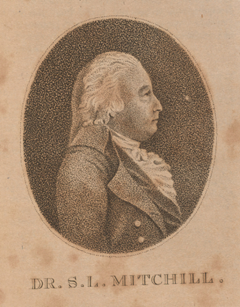 In December 1802, the "living encyclopedia" Samuel Latham Mitchill (1764–1831), was a freshman member of Congress residing in the new capital of Washington. Mitchill wrote a letter to his wife Catharine (née Akerly 1778–1864) back home in New York. Samuel and Catharine were still newlyweds, having been married in 1799 when Mitchill was teaching chemistry, botany, and natural history at Columbia College.
In December 1802, the "living encyclopedia" Samuel Latham Mitchill (1764–1831), was a freshman member of Congress residing in the new capital of Washington. Mitchill wrote a letter to his wife Catharine (née Akerly 1778–1864) back home in New York. Samuel and Catharine were still newlyweds, having been married in 1799 when Mitchill was teaching chemistry, botany, and natural history at Columbia College.
Mitchill, born in Hempstead, New York, graduated from the University of Edinburgh Medical School in 1786. An admired and enthusiastic know-it-all, Mitchill loved to pontificate on anything and everything. Familiarly known as Dr. Mitchill, he was a "chaos of knowledge," and to Thomas Jefferson he was the "Congressional Dictionary." Throughout his life, the national press considered Mitchill an authority whenever there was a question of science or natural history.
Mitchill wrote to Catharine that he had "an Anecdote to give" and then went on to describe a rumor he had heard about the identity of the model for Liberty on United States coins, the "effigy of this coy wood-Nymph" seen on "our Cents, Eagles, &c." He said the "Chief Engraver of the Mint, looked to his own Wife" and "made Copy from that Original." Since "Her face appeared to him beautiful enough to furnish a Model for ‘Liberty.'" Mitchill concluded, "They say she is well known in Philadelphia, tho I have never seen her."
The full transcription of this passage is below.
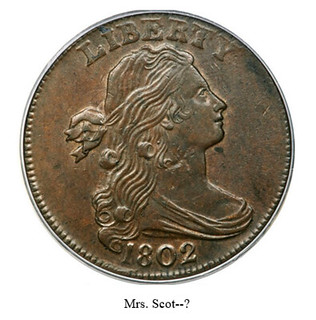 Mitchill may be an untapped source of numismatic learning, as, besides this 1802 letter, I have recently uncovered another intriguing statement linked to him (more to come later!). Since the Newman Numismatic Portal has been unavailable, I consulted Joel Orosz (who is the next best thing) to ask what he knew of Mitchill. In the words of Joel, "Samuel Latham Mitchill is a big name—one of the foremost scientists in the young republic. His Medical Repository published the first inventory of a significant American coin collection in 1801 (that of Rev. John Christopher Kunze)." Joel added, "It appears that SLM might have a lot to teach us about the cradle days of numismatics in the United States."
Mitchill may be an untapped source of numismatic learning, as, besides this 1802 letter, I have recently uncovered another intriguing statement linked to him (more to come later!). Since the Newman Numismatic Portal has been unavailable, I consulted Joel Orosz (who is the next best thing) to ask what he knew of Mitchill. In the words of Joel, "Samuel Latham Mitchill is a big name—one of the foremost scientists in the young republic. His Medical Repository published the first inventory of a significant American coin collection in 1801 (that of Rev. John Christopher Kunze)." Joel added, "It appears that SLM might have a lot to teach us about the cradle days of numismatics in the United States."
Joel's mention of Mitchill's Medical Repository steers us to another of Mitchill's eccentric claims to fame. Mere months after he wrote to Catharine about our fair Liberty, Mitchill was strenuously promoting his plan to rename the United States of America as "Fredon" or the poetic "Fredonia." Mitchill believed that "American" had been twisted into a pejorative by the British and that a native of this land should be able to proudly declare himself a Frede, "instead of using the tedious circumlocution that he was ‘a citizen of the United States of America.'" Not to mention that "notice will be taken of the association of Fredonia and Macedonia and Caledonia as a word equally potent and melodious in sound."
Needless to say, Mitchill's campaign was not successful. However, the dream of Fredon was popular enough that we can still find it memorialized today, such as by the Village of Fredonia in western New York.
As to his 1802 letter to his wife, it seems that Mitchill must be referring to US Mint Chief Engraver Robert Scot. However, I have found very little about Scot's wife (said to be Eunice Beal, 1751–1806). Perhaps, though, E-Sylum readers have some other thoughts about Mitchill's "Anecdote."
Some of Mitchill's letters have been scanned and transcribed at the University of Michigan, and this letter and others can be found here: https://quod.lib.umich.edu/m/mitchill/
I have an Anecdote to give you concerning our American Coins. The law provides that an emblematical Figure of Liberty shall be impressed upon the Productions of the American Mint. In consequence of this you see our Cents, Eagles, &c, all bearing the effigy of this coy wood-Nymph. It has commonly happened that Sovereigns and Princes have caused their own likenesses to be stamped upon the money issued during their own Times. The jealous Republicanism of our Country has prevented the exhibition of the Presidents face upon these circulating peices of Metal, and to avoid flattering or complimenting any Individual in the Nation so much, has put the fancied likness of an allegorical King there. Now observe how this has operated. The face of Liberty was to be an human countenance. (These fictitious Personages are generally females.) And in determining what the profile of this Visage should be the cheif Engraver of the Mint, looked to his own Wife. Her face appeared to him beautiful enough to furnish a Model for "Liberty." He made Copy from that Original. And the Citizens of the U. S. who carefully prohibited the reproduction of the President's features on their Coins, have now the pleasure of beholding the fair and more engaging looks of the Engraver's Wife!
How do you like her? Did not her husband seize the opportunity of distinguishing her highly? They say she is well known in Philadelphia, tho I have never seen her.
I couldn't help but mention that in the movie Duck Soup, Groucho Marx was the leader of Freedonia (with two "E"s). Hail, Freedonia! -Editor
Joel added:
"Duck Soup is a great movie, and up until ten minutes ago, if you had asked me what connects the Marx Brothers and Samuel Latham Mitchill, I would have been utterly stumped. Fredonia Forever!"
References:
https://quod.lib.umich.edu/m/mitchill/
https://www.numislit.com/pages/books/7218/john-c-kunze/description-of-a-cabinet-of-coins-and-medals-ancient-and-modern
https://www.nypl.org/blog/2015/11/12/united-states-fredonia
https://www.google.com/books/edition/The_Medical_Repository/Ma4WAAAAYAAJ?hl=en&gbpv=1&bsq=fredon
NOAH WEBSTER DECRIES PLANS FOR U.S. COINS
Another interesting (and amusing) item found by Julia Casey is a 1792 letter attributed to Noah Webster opposing the use of the President or Eagle on U.S. Coins. Here's her transcription. Thanks! -Editor
Connecticut Courant, April 30, 1792
For the CONNECTICUT COURANT.
Messieurs PRINTERS,
SOMETIME ago I was reading the debates in Congress on the Mint Bill. It was proposed by the Senate (that aristocratic Junto) that the coins of the United States should, on one side, bear the figure of the President, with a view probably to do honor to the head of the Executive, and to render the coins of some historical use in ascertaining the chronology of political events at a future day. But I see the House of Representatives discovered a snake in the grass. The head of the President on coins! Why monarchy, aristocracy, and despotism would follow such a measure, as sure as a gun! Thanks to the shrewd microscopic minds of our southern brethren, we have escaped the snare—liberty stands her ground, and defies machination itself! Now if a Nero, a Caligula, or a Commodus: that is, an Adams, a Jefferson, or a Jay, or some such man that the people should elect, should hereafter be placed at the head of the Executive, and our Mint should be going at the same time, why we shall not have our pockets and purses secreting the heads of those monsters; we shall not be obliged to stare them full in the face every time we take an Eagle or a dollar from our pockets. Thanks to Congressional foresight, our freedom is yet safe and snug!
But, Messrs. Printers, what are we to have on the face of our coins? Why on one side Liberty, and on the other an Eagle. Liberty is a good device undoubtedly; but the Eagle, the Roman standard, the famous military Ensign, which, from the rank of the bird, among fowls, denotes sovereignty, and from its significance and use among the Romans, denotes conquest and despotism! This is indeed well placed on the reverse of liberty! They stand opposed to each other like two boxers at fisty cuffs. Like the Lion and the Unicorn in the British arms.
The Lion beat the Unicorn all about the town.
A piece of rhime I learnt when I was a boy, and which with little alteration, will well grace a corner of the National Gazette. I hope, in all conscience, this Roman Eagle may do no mischief; yet it makes the principal figure in the arms of the United States, and what is worse, it is the badge of distinction with the Cincinnati; that patriotic band of heroes, who, just before the Convention which gave birth to the present government, were forming schemes to give us a government of a kind well adapted to military men—I believe however it is all right. We ought to see no figures on coin which are disagreeable—no tyrants face should be stamped on the dear metals—for we should transfer our affection from the money to the man; from the man to his children—his measures—his principles—and then good bye, Liberty! Possibly once in an age the people might happen to choose for President a pretty good man, whose face on our dollars would not endanger liberty. In such case, it might be well to send addresses to him and praise him well—this is reward enough for the best man living; except our now President, whose fame and services will be preserved by an Equestrian Statue; but there will never be another such man; and so no occasion for more statues of Bronze. The chance is that nine tenths of our future Presidents will be clear devils—for when the Printer of the National Gazette is dead (an event very distant, I hope,) the patriotic people of the states will fall asleep. Indeed while this American Goose stands centinel over the "fiscal arrangements" of the treasury, I think the Secretary, with all his Gauls about him, will have good luck to surprise the castle of our liberties. But if cruel fate should take away our cackling centinel, and Gov. C—n, of New York should be left out of office, and S—l A—ms, B—n A—n, of Boston and their Printer should die or change their principles (of which however there is very little danger). I do not see but our state governments are gone, and with them life, liberty and everything else! However while there is life, there is hope—nil desperandum de republica.
Messrs. Printers, I see a committee of Congress have reported in favor of an Equestrian statue of our President—This I like—but the figure of the President on horseback is to be in Roman dress. What the toga? the purple of the Emperors? the robes of a Nero, a Caligula? It may be a good thing to borrow a dress from ancient Rome, as we have no dress of our own proper for the purpose; but Messrs. Printers, wont this dress endanger our liberties? I am an humble inquirer—I want information. Indeed on reflection, I think it is all right. There are in republican governments, which have equality for their basis, other great men besides Presidents—I am one of them; and if any man's face is impressed upon dollars, I think it should be mine; I have no idea of exclusive honors bestowed on men no better than myself. I think since we cannot all be partakers of this honor, to have our noses struck in gold and silver, and chinked in the pockets of posterity; we ought to vote against bestowing that honor on any man. I am no friend to distinctions! I am glad Congress thought of this in time to prevent it. Roman Eagles and Roman Robes can do no harm; for they have no competitors! Our Liberty is rare, Messrs. Printers.
PETER PUZZLE
[A Bibliography of the Writings of Noah Webster identifies Peter Puzzle as Noah Webster]
To read the complete book, see:
A bibliography of the writings of Noah Webster
(https://archive.org/details/biwr00skee/page/n493/mode/2up?q=puzzle)
FAIRFAX CLUB HOSTS ERROR COIN SPEAKER
CONECA board member and E-Sylum contributor Greg Bennick will be speaking at next month's Fairfax Coin Club meeting in Virginia. -Editor
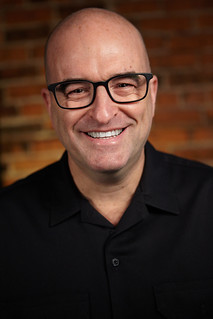 Board member Greg Bennick, from the error coin and variety club CONECA, will be offering
educational sessions about error coins and how they are made. The first of these presentations will
take place on the east coast for the Fairfax Coin Club. Mr. Bennick is available for coin club talks to
groups nationwide.
Board member Greg Bennick, from the error coin and variety club CONECA, will be offering
educational sessions about error coins and how they are made. The first of these presentations will
take place on the east coast for the Fairfax Coin Club. Mr. Bennick is available for coin club talks to
groups nationwide.
In these presentations, Mr. Bennick will be showing photos of coins from his personal collection and talking about how these errors were made at the mint. By learning about the minting process, collectors can begin to determine for themselves if the coin they happen across is, or is not, a mint made error. This is helpful for collectors of all experience levels.
Failures in the minting process leave clear clues that can inform collectors about the authenticity of their coins and whether or not they are errors. Education is a main goal of CONECA.
The east coast meeting is free and is open to the public with RSVP.
The east coast meeting will take place on November 12th 2024 at the Fairfax Coin Club (Vienna Community Center, 2nd Floor, 120 Cherry St. SE, Vienna Virginia 22180) at 7PM. All are welcome and are required to RSVP if interested by email: fairfaxcoinclub@gmail.com
Greg is a long-time error collector and researcher and enjoys sharing information about error coins so as to bring new people into the hobby. Error collecting has a fascinating history, and is somewhat modern compared to other subgroups in the collecting hobby. It only really has come into its own in the last fifty years, though error coins are known going back to ancient times. These talks will shed light on the history of the hobby and the coins themselves, offering new insight to a truly interesting aspect of coin collecting.
CONECA can be found online at https://conecaonline.org.
The club, whose name stands for "Combined Organizations of Numismatic Error Collectors of America," is the largest coin specialty club in the United States and has actively been educating collectors about mint error and variety coins for the last five decades.
CHRISTIAN GOBRECHT GRAVE MARKER
REMINDER: The Liberty Seated Collectors Club is installing a marker on the grave of U. S. Mint engraver Christian Gobrecht on November 13th. -Editor
Christian Gobrecht Grave Marker Unveiling
Christian Gobrecht, third Engraver of the United States Mint, died in office on July 23, 1844, and was succeeded by James Barton Longacre. Gobrecht was interred at Philadelphia's Monument Cemetery, at Broad and Berks Streets in North Central Philadelphia. By 1955, the burial grounds were dilapidated. With Temple University and the Philadelphia Board of Education wishing to acquire the land, the courts were petitioned for relocation of the cemetery. The following year, Gobrecht and family members were reinterred at Lawnview Cemetery in Rockledge, PA, a northeast suburb of Philadelphia.
Bill Bugert, in the July 2008 Gobrecht Journal (#102), described the search for the Gobrecht grave, an involved investigation that eventually uncovered a plain marker in the Lawnview location, that reveals simply "GOBRECHT." Gobrecht's headstone in 1844 was more fitting to his office, and to Vladimir Clain-Stefanelli goes the credit for preserving an image of the original marker, which Bugert believes was discarded in the 1956 relocation of the remains.
Accordingly, the Liberty Seated Collectors Club, collectors of Gobrecht's Liberty Seated coinage, has sponsored a new, black granite marker for the Gobrecht family grave, and an unveiling ceremony will take place on Wednesday, November 13, at 1 P.M., just prior to the Whitman Baltimore coin show. For further information, contact Dennis Fortier (ricajun@msn.com), Vice-President of the Liberty Seated Collectors Club.
This should be a great event - I understand the U.S. Mint will have a large contingent, including Mint Director Ventris Gibson, Chief Engraver Joseph Menna, and others. -Editor
Link to July 2008 Gobrecht Journal, including Bill Bugert's article "The Search for Christian Gobrecht's Birthplace and Final Resting Place":
https://nnp.wustl.edu/library/book/177
Link to December 2016 E-Gobrecht, including information on the original headstone:
https://nnp.wustl.edu/library/book/523821
For more information on the Liberty Seated Collectors Club, see:
http://www.lsccweb.org/
To read the earlier E-Sylum article, see:
CHRISTIAN GOBRECHT GRAVE MARKER UNVEILING
(https://www.coinbooks.org/v27/esylum_v27n43a23.html)
2024 C4 CONVENTION EDUCATIONAL PROGRAMS
The Colonial Coin Collectors Club (C4) has a great lineup of speakers for its upcoming Baltimore convention. -Editor
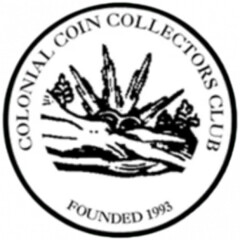 Chris McDowell, President, and Jim Glickman, National Vice-President and Education Chair of The Colonial Coin Collectors Club (C4) are pleased to announce the schedule of education programs as part of the 2024 C4 Convention, to take place in Baltimore on November 14-16, 2024 in connection with the Whitman Baltimore Fall Show. The programs will appeal to collectors of various levels of experience with colonial coins and currency.
Chris McDowell, President, and Jim Glickman, National Vice-President and Education Chair of The Colonial Coin Collectors Club (C4) are pleased to announce the schedule of education programs as part of the 2024 C4 Convention, to take place in Baltimore on November 14-16, 2024 in connection with the Whitman Baltimore Fall Show. The programs will appeal to collectors of various levels of experience with colonial coins and currency.
The schedule of programs starts off with two evening Eric P. Newman Lectures open to C4 members in person and to the public via livestream. The Newman Lectures will be given by Emily Pearce, Assistant Curator of Numismatics, Yale Art Gallery, and Kevin Vinton, noted colonial numismatic researcher and scholar. Videos of the Newman Lectures will be placed on C4's website, https://colonialcoins.org/ after the Convention. The programs also include two daytime lectures of a more introductory nature, open to the public to attend in person at the Whitman Baltimore Fall Show. The schedule of programs is as follows (all times are Eastern Standard Time):
Thursday evening, November 14, 2024: (Newman Lectures, open to C4 members in person as part of the C4 Social and Dinner, Sheraton Inner Harbor — check C4's website for details and room location. They can also be live-streamed at https://us06web.zoom.us/j/85809473680).
7:45 p.m. - Emily Pearce: "Accessing Numismatic Objects in Museums: The Yale University Art Gallery's Numismatic Collection"
9:00 p.m. - Kevin Vinton: "Fugio Cents in Institutional Collections"
Friday afternoon, November 15, 2024: (in person at the Baltimore Convention Center, Room 304 - check C4 website to confirm location)
2:00 p.m. - Jim Glickman: "Collecting American Colonials"
Saturday morning, November 16, 2024: (in person at the Baltimore Convention Center, Room 304 - check C4 website to confirm location)
10:30 a.m. - Bruce Smith: "Continental Currency: The Paper Money That Financed Our American Revolution"
The Colonial Coin Collectors Club is dedicated to the hobby of collecting American Colonial coins, tokens, medals and paper money and spreading and sharing knowledge of the hobby.
For more information about the Colonial Coin Collectors Club, see:
https://colonialcoins.org/
VOCABULARY TERM: PROOF FINISH, PART 1
Here's another entry from Dick Johnson's Encyclopedia of Coin and Medal Terminology. -Editor
Proof Finish. A very highly reflective metallic surface, mirror-like, produced by striking from specially treated highly polished dies and specially prepared polished blanks. Proof finish dates back to the 18th century (the first use of the term "proof" as applied to coins and medals is as early as 1762 in England). The concept was to display a perfect impression from a new die in all its sharp and fresh condition before any production run and wear was made from it. Even the name proof indicates – like a first copy of a print – the earliest and sharpest impression. Also called "specimen" or "master" coins in early US Mint documents and literature. The concept of mass produced "first impressions" did not occur until the 20th century with the boom of coin collecting.
Until the availability of reliable multi-strike presses in the late 1960s, all proof coins were made on a medal press using one blow from the dies.
Today mirror-like proof coins are made by polishing the dies and the planchets until the result is a mirror image surface on the struck piece. Now we have production run proof coins in the millions, and private mints issuing proof medals in the hundreds of thousands.
Proof finish, which starts with a craftsman in a die department (or tool and die department), is prepared by polishing the proof surface area in each die. The die itself is created by any normal method – hand cut or machined, cut by pantographic reduction or hubbed. The basic die is no different from any other production run die.
Proof polishing is done by a craftsman with a hand-held grinding wheel and a polishing compound, usually diamond dust or emery applied first and rouge afterwards. It should be emphasized that proof finish is in the die before the piece is struck – a proof finish cannot be applied to an already struck piece.
Full proof versus prooflike. A full proof or brilliant proof must have the full treatment of proof polishing and struck on polished blanks. Prooflike are struck from dies that have been augmented. After several hundred impressions proof dies often require another polishing treatment of the dies to effect a longer die life. After several thousand impressions a full proof die may exhibit wear.
To lengthen the life of the die, dies may be plated with chromium or nickel before they are placed in production – this results in a struck piece of high luster and looks almost like a full proof surface, but this is not a true proof surface. Pieces struck from any plated dies are prooflike. Thus without knowledge of the state of the die, whether the die has been plated or not and the type of planchets used, it is nearly impossible to differentiate between the two terms. It is understandable these terms are confused by the person viewing a struck specimen.
Matte proof finish. Some proof surface pieces have a portion of the surface with little or no reflective area – called matte (or mat surface). This is intended for artistic effect of contrast between high reflective proof areas and low reflective matte area.
The matte portion of the die is created with a treatment of dilute acid to lightly etch the surface. The acid is usually hydrochloric acid; it is available in a commercial matte chemical (see matte dip) or some diemakers make their own acid etching solution. The same matte effect can be obtained by light sandblasting (abrasive blasting) the surface (after masking off the area to be proof finished). Such matte finish is also called frosted surface.
Treating dies for proof finish. Dies are given a proof finish after they are fully cut and turned off to the proper profile to fit the intended press. To be able to strike a proof surface, each die must be given a proof surface (by proof polishing with diamond dust – called a polishing compound – and rouge using a power wheel).
Proof polishing is a low tech operation. Usually there are specially trained craftsmen who do this at a mint with long proof die production runs. It is usually women who are trained to do proof polishing because they are adept in such delicate and intricate work. The die is locked in a vise and the surface is coated first with diamond dust and the surface is polished with a hand-held grinding wheel and polished again with rouge. In medallic plants proof polishing is done in the tool and die department.
Proof polishing produces a brilliant mirror-like surface on the die that will strike a similar surface on the struck piece. Also dies can be treated for a matte proof finish by lightly etching the desired surface with acid or by light abrasive blasting.
When a die has both matte and proof surfaces, the matte is applied first. Matte solution is applied directly to the sunken portion of the die's design – usually the device – where the dilute acid is allowed to minutely etch the surface. It creates microscopic bites or cups. It must be immediately rinsed off to stop the etching action of the acid. During this procedure an unskilled craftsman could easily apply the acid to the area of the die that is intended to be proof polished. Such unintended etching is called a foul bite.
The proof polish is always done after the matte treatment of the die. Also for cameo proof surfaces the polishing is always done in full or in part of the field or background. This is done for several reasons: it is the highest portion of the die (easiest to proof polish), the lowest portion of the struck piece (which is protected somewhat by the rim and higher relief), and is usually the largest smooth area in a coin design (to emphasize the mirror surface).
Types of proof coin finishes. Numismatists have created a terminology to describe a number of proof treatments that have appeared on coins in the 20th century. Listed here are the most noted of these proof finishes:
• Brilliant Proof. The entire die surface is proof polished and this die is struck on highly polished, highly reflective planchets, the treatment is also called full proof. This produces a brilliant, mirror finish of the highest reflective surface. As an example U.S. proof coins of 1936-42 were issued in this brilliant proof finish.
• Frosted Proof. Any portion of a die is acid etched matte – usually the device – with all remainder brilliant proof. The device is lowest in the die, it is acid etched first, then the remainder of the die is proof polished. It is struck on polished planchets. Much of the charm of a frosted proof coin is the contrast between the two proof treatments to the design on each side. In general sculptors and coin designers did not like mirror-like finishes because they felt it interfered with their designs.
• Cameo Proof. A frosted proof usually with a portrait as device and lettering, both of which is matte with the background or field is brilliant proof. Cameo proofs must be struck on polished planchets.
• Matte Proof. The entire surface of the die is acid treated (or abrasive blasted) for a dull reflective surface. Typically struck on selected planchets. In US coinage terminology a "matte proof" is created by sandblasting or etching the die face prior to hardening of the die. This was used on Lincoln cents from 1909-1916 and Buffalo nickels from 1913 to 1916. It has not been used on any other U.S. coins.
• Sandblast Proof. A sandblast proof coin was made by striking a selected planchet with new dies using a medal press. The resultant satin coin was highly detailed. This was manually sandblasted much in the manner of a medal. Extremely fine-grain sand was used although the grit size varies from one production batch to another. Acid was never used for this purpose at U.S. Mints. Gold proof coins were sandblasted in 1908 and 1910-1915. Additional pre-production proofs were sandblasted for 1921 and 1922 Peace dollars and many commemorative half dollars. The purpose for these latter uses was to display the design to its maximum artistic effect.
To read the complete entry on the Newman Numismatic Portal, see:
Proof Finish
(https://nnp.wustl.edu/library/dictionarydetail/516560)
THE BOOK BAZARRE
FREDERICK HERBERT LAKOSKY (1894-1968)
E-Sylum Feature Writer and American Numismatic Biographies author Pete Smith submitted this article on forgotten collector Fred Lakosky of Wisconsin and Florida. Thanks! -Editor
I was intrigued by an article in the Hollywood Herald of November 2, 1951. I was unfamiliar with Fred Lakosky. What could I learn of the collector and his collection?
Lakosky was born in Newton, Wisconsin, on August 6, 1894. He was the son of Peter Laskowski (1863-1940) and Maria Susanna Zimmer (1863-1968). Peter was a farmer and later the owner of a saloon. In various records, the family name is spelled Laskowski and Laskoskie.
When he was four years old, he searched for Indian arrowheads on his father's farm near Manitowoc, Wisconsin. He also claimed that he found a 1652 pine tree shilling. He saved his allowance to expand both collections.
Lakosky was married to Susana Rysticken (1896-1929) on January 29, 1917. At the time he was employed as a ships carpenter. They had three children. His first wife died on March 1, 1929, as the result of an earlier fall. By the 1930 Census in April 1930, he was married to Frances Ann Will (1908-1987) and living with two of his sons. By the 1940 Census, he had a daughter and a son with his second wife.
In 1926 he was elected president of Loyal, Wisconsin, a town with a population less than a thousand. He served as mayor of Loyal for 19 years until he moved to Florida.
In 1929 he was the proprietor of the Loyal Implement Store. He also had a 160-acre farm three-quarters of a mile east of Loyal.
Lakosky was generous in sharing his collections with the public. At a Loyal antique show in 1934, Lakosky exhibited a clay tablet from Babylon claimed to be 3500 years old. He also had Swedish plate money dated 1741, United States paper money dated 1771 to 1778 and "all the issues since that time."
In 1940 he was selected as chairman of the county draft board. He refused to classify cheese workers as 1A believing they provided an essential service at home. He was a director of the Citizens State Bank and a charter member of the Loyal Rotary Club.
In 1943, he displayed his coin collection to the Neillsville Kiwanis and Rotary Clubs. The coins were displayed in shallow trays with all the coins cemented on green felt. The trays fit into a carrying case.
On October 1, 1945, he joined the American Numismatic Association as member 11707. The Numismatist reported on his activities with the Miami Coin Club where he frequently exhibited parts of his collection. Many times he would show coins or crowns from a letter or two of the alphabet.
He moved to Florida in 1946. Before leaving, he had a liquidation sale of his business inventory and advertised that he was attempting to sell his collection of 1000 books and 27,000 stamps.
In 1949, he had an armed escort to the International Invention and Hobby Show in Miami. His collection with an estimated value in excess of $50,000 was shown in the booth of the Miami Coin Club. The collection was described as "a complete series of United States currency and coins from 1862 to the present day." One of the coins was described as:
"A half dime made in the Philadelphia mint April 2, 1792, and one of the first coins minted by the U. S. government. According to the Standard Catalog of U. S. Coins, it was made from George Washington's personal silver." (I first read about this on the morning of Friday, October 25, 2024.) He also had an 1802 half dime I did not know about.
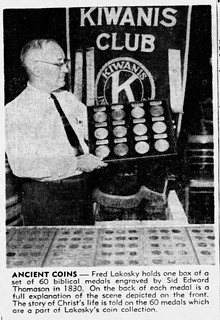 At the February 1956 meeting of the Miami Coin Club, Lakosky exhibited a complete set of barber dimes including the rare 1894-S. Lakosky's dimes were complete except for the 1873 dime with no arrows.
At the February 1956 meeting of the Miami Coin Club, Lakosky exhibited a complete set of barber dimes including the rare 1894-S. Lakosky's dimes were complete except for the 1873 dime with no arrows.
"There's only one of those known to be in existence. I bid $1,070 for it some years ago but lost out to Baltimore's Louis Eliasberg who owns a fine collection."
Leo Young conducted a sale in 1958 that included "The Famous Fred Lakosky Collection of Crowns and Talers of the World." This included more than 2000 pieces. One special coin was a 12 Taler of Brunswick-Luneberg with two examples known.
In 1959 he showed Indian relics at the Dania Bank lobby. He reported that a Miami museum was interested in buying his collection.
On September 12, 1962, Lakosky opened the door for two visitors interested in buying coins. They beat him, bound and gagged him. They carried off a small safe, two thousand silver dollars and boxes of old coins. Two men were charged in the robbery and three more were charged with receiving stolen property.
In 1963, he exhibited his collection of Indian relics at the First National Bank in Hollywood. He made some interesting statements that I believe were incorrect.
"The hard flint arrow and spear heads are particularly interesting, because as far as anyone can find out – and the world's best archeologists have studied the matter very thoroughly – the art of chipping the hard flint was lost in antiquity. Probably more than 10,000 years ago."
He also stated, "No relics of any consequence have ever been found in northern states." I could recount the hundreds of flint chips and intact arrowheads I found on a Minnesota beach in the 1960's.
He died in a hospital in Hollywood, Florida, on December 1, 1968, and is buried at Lauderdale Memorial Park in Fort Lauderdale.
A search of "Louis Eliasberg" on the Newman Numismatic Portal yields 1605 hits. A search of "Fred Lakosky" yields just seven. Both exhibited their collections to the public.
There are published rosters for surviving examples of the 1792 half disme, the 1802 half dime and the 1894-S dime. The Lakosky name does not appear on any of these lists. What happened to the coins from his collection?
Lakosky got little attention from the numismatic press during his lifetime. There was no public sale of his collection to indicate the quality of the coins. There was no promotional hype that goes with the sale of a collection. This article provides more information about him than all previous articles combined.
Fred Lakosky is not a common name. During the period of 1948 to 1968, there may have been three people named Fred Lakosky living in Florida.
Frederick Herbert Lakosky (1894-1968) was the former mayor of Loyal, Wisconsin, and coin collector then living in Ojus, Florida, four miles south of Hollywood.
Frederick P. Lakosky (1938-2018) was a police officer in Hollywood and the son of Fred H. Lakosky and his second wife Frances.
Frederick L. Lakosky (1924-1981) was a real estate agent and developer. His 1981 obituary lists his survivors as including brother F. P. Lakosky and sister Mary Huey, making him a son of Frederick H. Lakosky. He shares a date of death with Verland Leo Lakosky, second son of Frederick H. It appears that he assumed the name of Fred about the time he moved to Florida in 1948. For a while I had him confused with his father.
Thanks, Pete! It's hard work to pull together these threads of information and sort through the confusion. It's great to resurface an obscure collector with a major collection. Keep your eyes out for the name Fred Lakosky - it could be a new piece of the puzzle illuminating the fate of his collection and enhancing the pedigree chains of a number of rarities. -Editor
KELLEN HOARD INTERVIEW, PART THREE
Greg Bennick's latest interview for the Newman Numismatic Portal is with Young Numismatist Kellen Hoard. Here's the third part, where Kellen discusses his involvement in politics. -Garrett
GREG BENNICK: Nice. Very nice. Okay. So, coins are one part of it for you. Tell me about the political side of your reality because there's an intersection too, that we're going to talk about today.
 KELLEN HOARD: There's an intersection. One of them, I don't know if it's one you're referencing is how I got started in politics. I was at Summer Seminar, in 2017. I was 13 years old. I was sitting at a small table with some old men who were coin collectors and we were talking coins. One of them turned to me out of the blue and conspiratorially tells me, "Did you know Obama personally owns nuclear weapons?" I was 13 at that time. I was like, "That doesn't sound right, but I'm not a hundred percent sure." So I went back to the dorm, I was saying at Google, "Does Obama own nukes?"
KELLEN HOARD: There's an intersection. One of them, I don't know if it's one you're referencing is how I got started in politics. I was at Summer Seminar, in 2017. I was 13 years old. I was sitting at a small table with some old men who were coin collectors and we were talking coins. One of them turned to me out of the blue and conspiratorially tells me, "Did you know Obama personally owns nuclear weapons?" I was 13 at that time. I was like, "That doesn't sound right, but I'm not a hundred percent sure." So I went back to the dorm, I was saying at Google, "Does Obama own nukes?"
And obviously he doesn't own nukes. But in order to fact check that I started reading journals to figure out what was true and what wasn't. The more journals I read, the more hooked I got on it. This was in 2017 when there was a lot of political upheaval going on. I realized that what I was reading about was not only impacting just the world at large, but also me and the people I cared about. What I was reading in these pages in politics had pretty direct, substantive, tangible implications on my life and in my community. And not just at the federal level where a lot of people were looking, but the state level, especially. That's where the day-to-day stuff was happening.
Around that time, I got involved with March for Our Lives, when those walkouts were happening in schools. From there, there was a point at which I put my phone number into some kind of form, truly accidentally. And someone called me and said, "Hey, are you one of Manka Dhingra's interns?" Manka Dhingra was my State Senator at the time. And I said, "No, but tell me more." So, I ended up as one of her interns. From there on I got involved on the campaign side of politics.
And then later, as a result of the connections from the campaigns into the policy side, which we can talk about more if you want to, and at the state level.
GREG BENNICK: Yes, absolutely. I would love to hear about all of this. I think all of this is fascinating because I could ask you, "What do you collect?" And you say, "Indian cents." I say, "Great. Thanks everybody." And the interview is five seconds long. Or, we can find out more actually about you. I think it'll be great to build connection.
KELLEN HOARD: Okay! Well then sure, we'll go into a brief history of Kellen's political experience. Basically, after the campaign was over, I got hooked up with this group called the Legislative Youth Advisory Council here in Washington State, and they are codified in state law as the official youth advisory body to the state legislature. It's a two-year term. I was appointed. In my second year I became the Chair of the council. It's 22 young people from around the state who work closely with the legislature. During my chair year with the state agencies, we really expanded out to work with the Department of Health, and Department of Children, Youth and Families and the schools and everybody else to really provide that perspective, which is so often needed in policy making. When you are making policy without young people engaged, especially policy about young people, you end up with gaps and less effective policy, and less informed policy and less political support for your policy from the community.
So, there's a real opportunity there to get youth engaged that way. I was involved with that for quite a while and that really snowballed into a number of different things. A couple of the main highlights. One was that I got engaged with different campaigns, at different levels and had a great time doing that. The other one was that I was the Student Editor of my newspaper in high school. Especially my senior year, when I was Editor and Co-Editor-in-Chief. Coming back from the pandemic and I said, "Let's go bold on this story. Let's not just do fluff." The school district did not take kindly to that. The District Communications Director made it be known that we were no longer student journalists who were allowed to speak to our own teachers or any district employees without her permission.
And we found that pretty unconscionable, to say, "Hey, you just can't tell public employees they can't speak to their students." So, we got lawyers involved. We did a public pressure campaign, private pressure campaign, and got the policy overturned. The employee left the district later and we won a National First Amendment Award. That got me really involved with student free press, which is a whole separate tangent, which we will talk about sometime. But the long and the short of it is that, since the 1980's, the Supreme Court has ruled that schools can censor student journalists or students for pretty much any reason. They technically had to have a pedagogical reason, but that's super arbitrary.
In effect, principals and school administrators will censor student journalists. Because they're embarrassed about what some of the students are writing, or perhaps, they just don't like it. Well, maybe they're writing about teen pregnancy or maybe they're writing about bad school infrastructure or maybe they're writing about anything, and if the principal doesn't like it? It gets censored. I think that's wrong, both on a moral level because students have the same free speech rights as the rest of us. And also on a practical level, we're trying to raise students to be young citizens, and so, by discouraging them from talking about the issues of the day, you are actually hurting your ability to do that. Also on a practical level, as local media dies, as local news outlets shutter constantly, student journalists are filling that void.
One in ten statehouse reporters today are student journalist. They're the ones covering their school boards and local communities. So, if we're censoring them arbitrarily, we're doing even more damage to local news. So, I've been involved with this movement called the New Voices Movement to really go state-by-state in state legislatures and pass laws which counteract the Supreme Court ruling and say, "Hey, student journalists have the same free speech rights as the rest of us." Of course, they can't be libelous or slanderous or break school rules or the law. There are exceptions, of course. They can't evade privacy but they have the same free speech rights.
Then also their teachers can't be reprimanded or fired for just defending those rights, which is often a problem you run into. So, I got really engaged with that. My home state of Washington already has one of the laws, but last year I was looking around. I had a background in lobbying through the youth council and through other non-profits. I've worked extensively with a number of different non-profits. So, I had a background in advocacy. I said, what would be a fun challenge? And I landed on West Virginia, which is about the most different state as you can get from Washington politically.
I called up a state senator there and he and I discussed it. We disagreed on just about everything except for this. I gave him a bill text. He liked the bill. He'd actually sponsored a similar one before and we got it passed in a couple of months. That was really kind of great. I've continued that work as well. What I really see with policy is that there's an opportunity at the state and local level, especially as an individual, to have a huge amount of impact. At the federal level, as an individual, you have relatively little power. It's at such a huge scale. At the state and local level, individuals can do so much. It's truly a pretty fascinating amount.
When I was in high school during the pandemic, mental health was a big issue. There was a huge mental health struggle, especially among young people. I heard this from young people I was talking to, especially through the Youth Council. And so, I talked with the state representative here in Washington state and we wrote up a bill text that would expand mental health access to a million students around the state. She sponsored the bill and I think like seventy days later, we passed it. It was just me as an individual, right? But by bringing my community together around this, we were able to get it passed. That's not really something you see at the federal level as well. So, then there was that.
And then the more recent kind of political development, even beyond nonprofit work I was doing, I've worked with nonprofits like PEN America in college who do freedom of speech work as well. I was working on their academic freedom team to protect classrooms from legislative interference at the university level, working with the Democratic Attorney General's Association to raise money for candidates there. But I was recently appointed to the board of something called Washington Conservation Action. So, it's the board of the leading environmental nonprofit in Washington state.
And how I ended there was a little odd. Basically, one of my main areas I work with, with nonprofits and with elected officials and private sector officials is getting young people engaged, right? And this is a totally nonpartisan thing, but it's in my view, young people really have a different system of thinking to contribute to organizations. So, what I say to nonprofits is, "If you don't have someone under 25 on your board of your nonprofit, you are missing opportunity and you're missing risk by not having that system of thinking represented on your board." It's not just a different life experience, but actually a different approach to the world, right?
If you're a private sector leader, you don't need necessarily young people on your board, but you should have them, people under 25, throughout your organization, talking to your C-suite leadership regularly. Once, twice a month, you should have someone in marketing and sales and HR, someone under 25 talking to your leadership team and saying, "Here's what we're seeing." If you're a public leader, like a public official, you should be going to schools once or twice a month and having a dialogue with students, not just talking at them, but having a dialogue. You should have a youth advisory council advising you on your role and your campaign. You should have young interns engaged.
Having young people allows you access to new opportunities and to new opportunities in line with your mission. And it saves you from systemic risk and demographic blindness. So, I ended up, you know, making that pitch to the environmental nonprofit. I ended up on their board and that's been an insightful way to look at state politics. But also, I've continued that work even beyond that, I co-founded the Civically Engaged Youth Council through the Seattle City Club. I don't know if you've encountered them ever. They do civil dialogue work to really try and help to make sure that we're getting young people into positions of authority, getting them a seat at the table.
And that applies to coins too, for that matter, but that's a separate thing as well. But getting young people to sit at the table so that they can help guide this forward and actually make better policy, make better organizations, make better society. So that's a long answer. I hope that was what you're looking for, but that's what I've been interested in.
GREG BENNICK: I love it. You and I are kindred spirits and not to throw this interview off the rails by telling you Greg's life story. And I hope that people are still with us. Anyone who's still with us and watching at this point are exactly our people, right? So, there was a law on the books in the city of Seattle called the Teen Dance Ordinance for many years. Which prevented all ages music shows from happening. This is going to be a 30 second version of a three-hour explanation. But my friends and I didn't think that that was fair. We think that art should be able to be accessed by people of all ages.
So, my friends and I petitioned and talked to people and tried to get meetings with city council members and talked to the mayor for many years. And the long story short is that the law was replaced by a law called the All Ages Dance Ordinance, which I wrote with my friend Dave Whitson, submitted to the city, passed through. The current law on the books in the City of Seattle that governs all ages music and allows access to the arts for people of all ages is the law that I wrote with my friend Dave. So, you and I are kindred spirits.
KELLEN HOARD: That's great. I mean, that's the thing, right? You have an ability as an individual or a group of people to, (bring about change). They're literally closer to you, these elected officials. They have a smaller constituency. So, you have amplified power and they're often part-timers. Like that's a big part of this as well. This is not the main thing. State legislators, they do this a couple months a year. These aren't professional year-round politicians. These are people who are often enmeshed in their communities to a certain level. They have that somewhat higher level of responsiveness. So, I am so glad to hear that. That is so neat.
GREG BENNICK: Yeah, it's fun. And what I love in listening to you is that this is the embodiment, the perfect example, of one person can make a difference, which often sounds like just such like a trite thing to say. It's so true. Especially in the context of what we're talking about. You really can. If you see something that you don't like, something you do like, you want more of, through your voice, amplifying your voice, you can go out and transform your world. There's no question about it.
KELLEN HOARD: The walls of the political institutions are less high than you think.
 About the Interviewer
About the Interviewer
Greg Bennick (www.gregbennick.com) is a keynote speaker and long time coin collector with a focus on major mint error coins. Have ideas for other interviewees? Contact him anytime on the web or via instagram @minterrors.
To watch the complete video, see:
Kellen Hoard Interviewed for the NNP by Greg Bennick
(https://youtu.be/tBb-Bt4NR8k)
To read the complete transcript, see:
Kellen Hoard Interviewed for the NNP by Greg Bennick (Transcript)
(https://nnp.wustl.edu/library/book/641580)
To read the earlier E-Sylum article, see:
KELLEN HOARD INTERVIEW, PART ONE
(https://www.coinbooks.org/v27/esylum_v27n41a24.html)
KELLEN HOARD INTERVIEW, PART TWO
(https://www.coinbooks.org/v27/esylum_v27n40a13.html)
NUMISMAGRAM MEDAL SELECTIONS: OCTOBER 27, 2024
Numismagram's Jeremy Bostwick sent along these three medals from his upload of new Halloween-themed medallic art to his site. For all of the new items, please visit https://www.numismagram.com/inventory. -Editor
102951 | FRANCE. Rouen. Freemasons silver Medal. Restitution issue, circa 1920-1940. The Loge de la Parfaite Egalité (33mm, 15.56 g, 12h). Paris mint. Two skeletons—one crowned and holding scepter, the other holding crozier and level—standing facing one another; altar surmounted by open book between them; radiant tetragrammaton above; to left and right, pillars of the First Temple (Solomon's Temple), marked J and B (for Boaz and Jachin); at their bases, compass and carpenter's square // LOGE DE LA PARFAITE EGALITÉ O DE ROUEN, Square and Compasses: set of compasses joined with carpenter's square; within, radiant pentagram containing the letter G (representing geometry or the Great Architect of the Universe); intertwined sprigs of acacia (referring to the legend of Hiram Abiff) around. Edge: «cornucopia» 1 No. 126/500. Cf. Labouret 721 (for original issue). Extremely Fine Details. Cleaned, with some deeper toning beginning to reappear nearer the peripheries. Extremely appealing and interesting type featuring masonic and haunting imagery. $465.
Freemasonry in France began to grow in the early 18th century, with numerous lodges forming throughout the remainder of the century until the aftermath of the French Revolution caused the majority of them to close down briefly. Upon the formation of the French Empire under Napoléon I, many of these closed lodges opened again, further continuing their expansion. The Loge de la Parfaite Egalité at Rouen appears to have been initially formed on 9 March 1786 and, at the time of re-opening in 1803, had 37 active members. In 1806 it was reorganized, containing 60 members, while in 1857, it had 56 members and in 1881, 61 members. In 2012, the lodge was again reorganized and reopened.
To read the complete item description, see:
102951 | FRANCE. Rouen. Freemasons silver Medal.
(https://www.numismagram.com/product-page/102951)
102616 | GERMANY, GREAT BRITAIN & EGYPT. The Awakening of Egypt cast iron Medal. Dated 1915. "Ägypten erwacht" (57mm, 50.14 g, 12h). By Karl Goetz in München. SIR GREY ZEIG'DEINE MACHT! (Sir Grey, show your strength!"), facing bust of Sir Edward Grey (1st Viscount Grey of Fallodon), with a concerned look on his face, clasping his hands together in supplication and sweating rather profusely; behind to right, Death (as a skeleton) whispering into his ear and holding an hourglass over his other shoulder // Sphinx right, with head left, seated upon ground line inscribed ÄGYPTEN/ERWACHT (Egypt awakens) in two lines; in background, star and crescent (representing the Ottoman Empire) over the pyramids, with Ottoman troops rallying. Edge: Plain. Kienast 166; Klose –; The Art of Devastation –; Jones, Dance of Death –; Frankenhuis 1433. PCGS MS-61. Deep charcoal gray surfaces, with a lighter, dustier hue in some of the recesses, allowing the eye sockets of the skeleton to provide further intrigue. An extremely haunting issue. $895.
Following the defeat of Egyptian forces in the Anglo-Egyptian War of 1882, Great Britain occupied the former Ottoman province, though the latter empire still claimed suzerainty even after Egypt was declared a British protectorate in 1914. In order to formally reinstate their influence in the region, Ottoman forces attacked British forces in Egypt the following year, with regional powers during the first world war starting to align themselves. This particular medal was a jab by Goetz at Sir Edward Grey, then British Foreign Secretary, urging him to stand up to the rising unrest against the British occupation of the region.
To read the complete item description, see:
102616 | GERMANY, GREAT BRITAIN & EGYPT. Awakening of Egypt cast iron Medal.
(https://www.numismagram.com/product-page/102616)
102886 | BELGIUM. "Femme Fatale" oval uniface cast bronze Medal. Issued 2017 (86mm x 104mm, 314.4 g). By Paul Huybrechts. Female dancing facing atop sphere, with hands raised overhead and with six arachnoid appendages emanating from her back; web in background // Blank, with a shell-like nature that recesses nearly the entire thickness (10mm). Edge: Plain. Cf. JEGMP 2018, p. 78 (for one of the other examples that has had enameling in red and blue in some spots). Essentially as made. Deep brown surfaces, with some lighter hues upon the higher points. Extremely rare, and one of just three cast. $435.
To read the complete item description, see:
102886 | BELGIUM. "Femme Fatale" oval uniface cast bronze Medal.
(https://www.numismagram.com/product-page/102886)
DAVISSONS E-AUCTION 50
Davissons is holding their E-Auction 50 on October 30th. Here's a preview of the sale's British Trade Token section with Allan Davisson's reflections on the classic reference Dalton & Hamer. But there's much more than tokens in the sale - see below for links to earlier announcements highlighting Greek, Roman, Scottish and other coinage. -Editor
The late Eighteenth Century token series has been an important part of our business since we started issuing catalogs. My fascination with the series started with a few pieces I got from a dealer at a small show in the late 1970's — inexpensive and relatively high-grade examples of copper pieces nearly two centuries old at the time I began.
By the mid 1980's I realized that there was a problem finding the huge reference volume that had been published in parts in the teens (20th century, not 19th) and even the reprints were rare and not printed as clearly as the technology of the late 1980's allowed. So, I had both a good reason and a good excuse to spend time, energy, and money in an effort to not only reprint a higher quality edition of Dalton and Hamer but also to make an effort to find new varieties of the series.
In short, I spent about three years traveling, buying, and putting together the edition of Dalton and Hamer we published as the 1990 update. I acquired two original sets of the 1910 to 1918 series of publications and selected the best example of each page to have photographed by the printer. We used the best gray scale images possible of the collotype continuous gray scale images used in the originals. Our 1990 update and later editions all sold out fairly quickly and I began to notice that our edition was often cited in sale catalogs.
And the series continues to appear in all of our sales. Now, as when I began, it offers a look into a period when manufacturing coins became technically superior to what had been done in earlier years, and collecting these "unofficial" pieces became popular. Two names stand out — Matthew Boulton and the Soho Mint at Birmingham, and James Conder of Ipswich, the first to publish a catalog of the series that reached the United States (and led American collectors to title the series "Conder tokens").
Since its first publication Dalton & Hamer (D&H) has remained a powerful definition of the series. I am unaware of another century-old publication whose original descriptions and order has remained strictly definitive for such a highly popular area. (Sheldon's numbers—over a half century old—are still the basis for US large cents but I have 6 3/4 inches of tall hardbound volumes on my library shelf that further explicate US large cent series.)
There have been catalog publications and proposals to rearrange the pieces in Dalton and Hamer, and regular collectors of the series have seen these rearranged catalogs. Some make an effort to list by a more accurate geographical base. Some of the locations in Dalton and Hamer are placed in what is now considered the wrong county. Others have decided to list in order of manufacturer. None of the new configurations seem to have stuck. The latest token sale catalog I have on my desk came from Baldwin's—a new firm that took over the old Baldwin's along with the name. They have tried other formats but have returned to the traditional D&H order. (They also cite our 2004 edition in their list of references.)
All this discussion was stimulated by watching the PBS show Antiques Roadshow which has been rerunning old versions and then comparing prices now with prices a decade or two ago. By my unofficial count, something over 60% of the pieces have had their value either stay the same or decrease. Fashions and enthusiasms change over time. But the amazing thing about these pieces of copper—trade tokens, political tokens, artistic expression tokens, satirical tokens, temperance tokens (yes, there is one in this sale), royal event tokens (or medals if you prefer), vanity tokens—they are all there and they are all as fascinating to us now as they were to people in the past like Waters, Cokayne, Birchell, Spence, Sharp, Chetwynd, Atkins, Pye, and many more of us still enthused about this fascinating chapter of numismatic as well as British history.
 This catalog contains many choice pieces from several impressive collections that have come our way. I hope you enjoy them.
This catalog contains many choice pieces from several impressive collections that have come our way. I hope you enjoy them.
For more information, or to bid, see:
https://davcoin.com/sale/E-Auction%2050
See also:
Sale overview
(https://mailchi.mp/davcoin/welcome-to-e50)
Greek & Roman sections
(https://mailchi.mp/davcoin/greek-roman-e50)
British Isles section
(https://mailchi.mp/davcoin/scotland-plantagenet-e50)
Allan reflects on Dalton & Hamer
(https://mailchi.mp/davcoin/dalton-hamer-e50)
KUENKER AUCTION 417
Künker's auction 417, taking place on 31 October 2024 as an eLive Premium Auction, is dedicated to the general collection Roma Universa. It is part 9 of the Dr. W.R. Collection and covers the period from the era following Nero's death up to the end of the Severan dynasty. -Garrett
Künker, Osnabrück
Auction 417
Osnabrück, 31 October 2024
Roma Universa: Part 9 of the Dr. W.R. Collection at Künker
Part 9 of the Dr. W.R. Collection will be offered by Künker as eLive Premium Auction 417 on 31 October 2024. The 682 lots cover the period from the time after Nero's death to the end of the Severan dynasty. As always, the Dr. W.R. Collection unites all fields of Roman numismatics. The collector was interested in gold, silver and bronze coins, in issues from the mint in Rome but also in local coins produced in the various municipal centers of the provinces. In doing so, Dr. W.R. always paid utmost attention to the quality of his pieces. But their historical background was also an important factor. Therefore, this collection contains numerous coins with interesting reverse depictions. The estimates of the individual lots range from the low 2-digit to the mid 4-digit segment.
We present a little selection of particularly interesting pieces.
No. 3011: Otho, 69. Antiochia / Syria. Tetradrachm, year 1 (= 69). Very rare. Very fine +. Estimate: 2,000 euros
No. 3015: Vitellius, 69. Sestertius. Rare. Very fine. Estimate: 5,000 euros
No. 3037: Diva Domitilla. Denarius, 82/3. Very rare. Very fine +. Estimate: 1,500 euros
No. 3051: Bone token, 80. Probably unique. Very fine. Estimate: 500 euros
No. 3052: Julia Titi. Denarius, 80/1. Rare. Extremely fine. Estimate: 600 euros
No. 3061: Domitian, 81-96. Aureus, 81. Very rare. Extremely fine. Estimate: 5,000 euros
No. 3083: Domitian, 81-96. Caesarea Maritima / Judaea. As, 92. Rare. Extremely fine. Estimate: 750 euros
No. 3103: Nerva, 96-98. Aureus, 97. Rare. About extremely fine. Estimate: 6,000 euros
No. 3161: Plotina. Denarius, 112-114. Very fine. Estimate: 1,000 euros
No. 3180: Hadrian. Denarius, 130-133. Extremely fine +. Estimate: 400 euros
No. 3293: Marcus Aurelius, 161-180. Ephesus / Ionia. As, 161-165. Very rare. Extremely fine. Estimate: 1,000 euros
No. 3324: Faustina II. Aureus. Rare. Extremely fine. Estimate: 6,000 euros
No. 3349: Lucius Verus, 161-169. Aureus, 161/2. Extremely fine +. Estimate: 7,500 euros
No. 3450: Manlia Scantilla. Denarius, 193. Very rare. Very fine. Estimate: 1,250 euros
No. 3499: Septimius Severus, 193-211. Attuda / Caria. As. Probably unique. Extremely fine. Estimate: 3,000 euros
No. 3553: Julia Domna. Emesa / Syria. Tetradrachm, 215. Very rare. Extremely fine +. Estimate: 1,000 euros
No. 3555: Diva Julia Domna. Denarius, 218, minted under Elagabal. Very rare. Very fine +. Estimate: 750 euros
No. 3606: Caracalla, 198-217. Soli-Pompeiopolis / Cilicia. As. Very rare. Very fine. Estimate: 2,000 euros
The academic Crantor of Soloi (c. 335-275 BC) is mainly known for his commentary on Plato's Timaeus. In this commentary, he makes it clear, among other things, that Plato considers the cosmos to be eternal and not created at a certain time. This view shared by the academics had been attacked by certain sophists since late antiquity. Proklos Diadochos defended Plato's view, and by extension Crator's, in De Aeternitate Mundi with 18 arguments.
No. 3648: Plautilla. Akrasos / Lydia. As. Probably unique. Very fine +. Estimate: 1,000 euros
Please note that this auction is part of Künker's October auction week, which consists of three auction sales.
- Auction 415 on 28 October 2024 presents orders, decorations as well as many other numismatically interesting medals, including from the estate of Alexander Eugen Herzog of Württemberg and Carl Theodor in Bavaria.
- Auction 416 on 29/30 October 2024 features ancient coins from various possessions, including the Dr. Eike Druckrey Collection.
- Auction 417 on 31 October 2024 was presented in this preview.
To order a catalog contact Künker, Nobbenburger Straße 4a, 49076 Osnabrück; phone: +49 541 / 962020; fax: +49 541 / 9620222; or via e-mail: service@kuenker.de. You can access the auction catalogs online at www.kuenker.de. If you want to submit your bid from your computer at home, please remember to register for this service in good time.
STEPHEN ALBUM INTERNET AUCTION 29
Here's the announcement for the November 2024 internet auction from Stephen Album Rare Coins. -Editor
Stephen Album Rare Coins will be holding their Internet Auction 29 on November 4th and 5th, 2024 at their offices in Santa Rosa, California. Among the 1,800 lots in the auction is an extensive selection of World Coins, in addition to the usual Ancient, Islamic, Indian, and Chinese section. This is an opportunity to acquire items with starting prices ranging from $15 up through $850.
Some highlights from the sale are as follows:
LOT 1440: WORLD: ARGENTINA: RIO DE LA PLATA: Republic, AR 8 reales, 1827 RA-P, KM-20, sunface, some chatter in the reverse fields, a few scarcely noticeable hairlines, chemically cleaned, a nice example of this sought after crown, XF. Estimated at $600 to $800.
LOT 1065: WORLD: SAXONY: Friedrich August III, 1763-1806, AR conventionsthaler, 1795, KM-1027.2, Dav-2701, initials IEC, very lightly cleaned, PCGS graded UNC details. Estimated at $200 to $300.
LOT 1705: CHINA: CHIHLI: Kuang Hsu, 1875-1908, AR dollar, Peiyang Arsenal Mint, Tientsin, year 34 (1908), Y-73.2, L&M-465, cloud-connected variety, PCGS graded XF40. Estimated at $200 to $300.
LOT 1798: CHINA: TIBET: AR rupee, ND (1902-11), Y-3.1, L&M-360, Szechuan-Tibet trade issue, small portrait of the Chinese emperor Guang Xu without collar // horizontal rosette at center, Chinese inscription si chuan sheng zao ("made in Sichuan"), branches with cusps and flowers around, PCGS graded XF45. The Sichuan rupees of this type from the Chengdu mint ranged from .880 to .935 fine silver. Estimated at $200 to $300.
LOT 56: ANCIENTS: SICILY: Kamarina, AE tetras, ca. 420-405 BC, CNS-1, HGC-2/546, head of gorgoneion facing // owl standing right with head facing, grasping lizard in left talon, KAMA behind, three pellets (mark of value) in exergue, gorgeous bold strike from a pair of well-engraved dies, Strike 5/5, Surface 4/5, NGC graded Choice XF. Estimated at $150 to $200.
LOT 666: INDIA: SIKH EMPIRE: AR rupee, Amritsar, VS1879, KM-20.1, Herrli-01.07.04, magnificent mint state example! NGC graded MS64. Estimated at $150 to $200.
The firm is now accepting consignments for future sales, including its next Premier auction in January 2025. For more information, see the firm's website at www.stevealbum.com .
DR. BUSSO PEUS NACHF. AUCTION 439
From November 4 through 7, 2024, German auction house Dr. Busso Peus Nachf. will be holding their Auctions 439-441. Below please find a description of the first auction as well as selections. -Garrett
All collectors and fellow dealers should make a note of this year's autumn auction in their calendars now!
The auction week begins on Monday, 4 November, an exception at Peus, and offers a particularly attractive selection of antique coins. Several entire collections have been included in the 1250 individual lots, some of which we would like to highlight here.
The Nummi Regnum Britonum (Coins of the Kingdoms of the Britons) collection focuses on the coinage of the ‘Celtic' tribal chieftains of the British Isles. It was built up between the early 1990s and the late 2000s with a focus on gold coinage and contains numerous rarities, many of which have not been offered for sale for many years. Ancient British numismatics, with its florid and sometimes local patriotic type designations such as ‘Gisleham Glory' and ‘Irstead Smiler', is a cosmos all of its own, into which the Nummi Regnum Britonum collection provides a fascinating insight.
The particularly rich part of Greek coins in this auction consists in its core of specimens from the collection of Dr Hans Maag (1929-2009), which complement the holdings we were allowed to offer in our auction no. 407 in 2012. These coins harmonise wonderfully with a collection of smaller silver denominations (up to drachms) from a collector who wishes to remain anonymous and attaches particular importance to both quality and provenance. Once again, illustrious pedigrees such as ‘ex Coll. Hermitage' (nos. 95 and 356) or ‘ex Metropolitan Museum' (no. 313) as well as numerous provenances from the period before the Second World War can be found in our catalogue, which also boasts dozens of plate specimens. Further high-quality but smaller consignments, including some ‘latecomers' from the Rudolf Hoesch Collection, ‘Hunting and Animals', which was sold very successfully in Auction 438, round off the range of Greek coins on offer.
Anyone browsing through the section of Roman coins will notice that this auction features a particularly large number of Aes coins, especially sestertii, with a focus on the popular ‘philosopher emperor' Marcus Aurelius. Most of these pieces come from the holdings of a deceased collector from the Rheingau region, comprising around 500 specimens, from which we were also able to create attractive and collector-friendly lots. The centrepiece, however, is a part of a large collection of often excellently preserved denarii from the middle price segment, supplemented by an opulent lot of late antique gold coins.
The special collection ‘de face' concluding the ‘Antique Day' of our auction 439 forms a separate catalogue section in order to highlight the special nature of the chosen collection theme. ‘De face' is the elegant French technical term for frontal depictions, and so leafing through this collection - and especially the elaborately designed plates - offers a rare experience: from every catalogue page and from every single coin, faces gaze out at the viewer, be they those of gods, heroes, monsters or even crabs.


Lot 144. Syrakus, Dionysios I., 405-367 v. Chr. Gold-Tetradrachme (20 Litrai) 405/400 v. Chr. GOLD Seltene Variante, vorzüglich
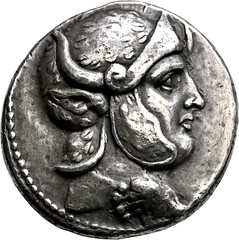
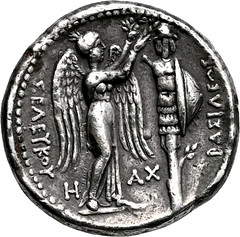
Lot 356. Seleukos I. Nikator, 306-280 v. Chr. Tetradrachme 305/295 v. Chr., Susa. Kabinettstönung und von illustrer Provenienz Gutes Sehr schön
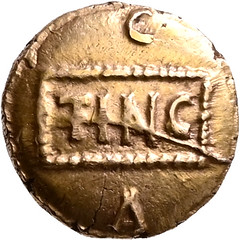

Lot 1001. Atrebates und Regini, Tincomarus, 25 v.-10 n. Chr. Goldviertelstater GOLD Feine Goldtönung, Sehr selten, vorzüglich
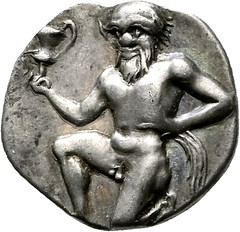
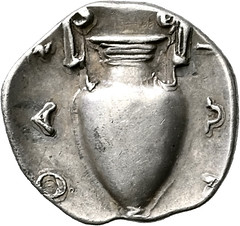
Lot 1085. Insel Thasos, Trihemiobol 412/404 v. Chr. Feine, teils irisierende Tönung Doppelschlag im Revers, vorzüglich
The range of medieval and modern coins on offer is so large that 3 days, from 5 to 7 November, must be planned for it.
After the usual coins and medals from all over the world and from the Habsburg hereditary lands, the collection of bracteates from a southern German collector will appear as a whole, ahead of the remaining coins from the old German states. Comprising over 180 lots, the collection represents the entire spectrum of bracteate coinage from central Germany to the mints around Lake Constance at low and medium price levels.
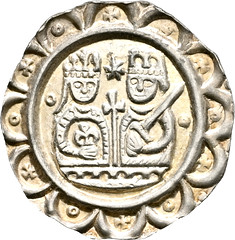
Lot 1787. Donauwörth, königliche Münzstätte. Heinrich VI. von Hohenstaufen, 1190-1197, Brakteat. Selten Fast Stempelglanz
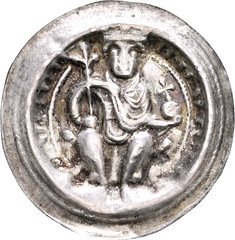
Lot 1793. Frankfurt, Reichsmünzstätte. Heinrich VI. von Hohenstaufen, 1190-1197, Brakteat. Sehr schön
As usual, the coins and medals of the Feudal German states follow through all centuries, in all metals and in all price categories. Remarkable is the number of thalers before 1800, which are distributed alphabetically throughout the catalog.

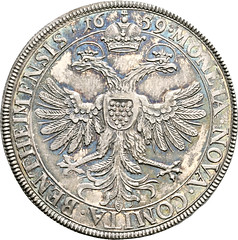
Lot 1972. Bentheim-Steinfurt, Grafschaft. Ernst Wilhelm, Reichstaler 1659, Münster. Prachtexemplar mit herrlicher Patina, Sehr selten Vorzüglich/Stempelglanz

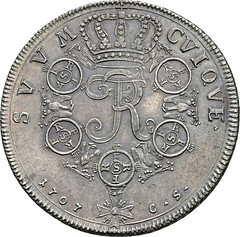
Lot 1977. Brandenburg-Preußen, Königreich. Friedrich I., Reichstaler 1707 CS, Berlin. Patina, Sehr selten Vorzüglich
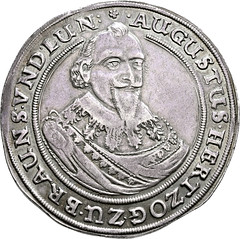

Lot 2027. Braunschweig-Lüneburg-Wolfenbüttel. August der Jüngere von Lüneburg-Hitzacker, Reichstaler o. J. (um 1650), Zellerfeld, "Reisetaler". Vorzügliches Prachtexemplar mit schöner Patina
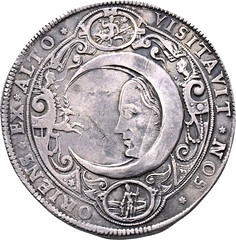

Lot 2458. Lüneburg, Stadt. Doppelter Reichstaler, o. J. (1637-1638), sogenannter doppelter Jagdtaler. Äußerst selten Sehr Schön
With over 150 individual lots from the 13th century to 1866, the coins of the imperial city of Frankfurt are represented in particularly large numbers and high quality.
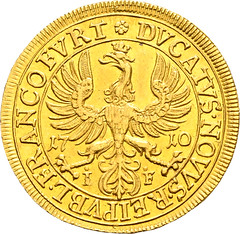

Lot 2128. Frankfurt, Reichsstadt, 1311-1806Doppeldukat 1710, "Doppelter Sturmdukat". GOLD Sehr selten Vorzüglich

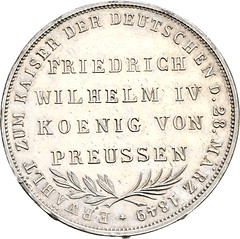
Lot 2201. Frankfurt, freie Stadt. Doppelgulden 1849, auf die Wahl Friedrich Wilhelms IV. zum Kaiser. Mit Randschrift. Vorzüglich/Stempelglanz
A collection of over 100 coins and medals from the County of Hanau up to the time of the Landgraviate of Hesse-Kassel must be mentioned, too. In particular, the numerous mining-thalers from the Bieber mines are worth a closer look.

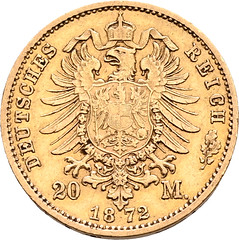
Lot 3021. Sachsen-Coburg-Gotha. Ernst II. 20 Mark 1872. J. 270. Äußerst selten, nur 1.000 Exemplare geprägt Sehr schön
Wednesday, November 6, belongs to German coins after 1871, and Dr. Busso Peus Nachf. is proud to offer an almost complete collection by years of gold coins from the German Empire as the highlight of the 439th auction. Among them are rarities such as the Bavarian 20 mark piece of the 1913 vintage year (J. 200) in outstanding condition, the Mecklenburg-Strelitz 10 mark piece of 1873 (J. 235) or the extremely rare 1877 vintage year of the Saxon 20 mark piece (J. 262). The highlight is the rarest type of all imperial gold coins: Saxe-Coburg-Gotha, 20 marks 1872 (J. 3021).
As usual with Peus, this closed collection is followed by the coins of the German Empire in gold and silver, the Weimar Republic and other areas from various owners. Here, too, some rarities can be found.
Paper money with rare banknotes of the high inflation, the Weimar Republic and the world wars, as well as numismatic literature follow.
As always, the traditional conclusion is formed by numerous favorably priced lots from all over the world and from all periods.
Thursday, November 7, still has 2 collections in store, each of which deserves its own hardcover auction catalog due to its size and importance.
DR. BUSSO PEUS NACHF. AUCTIONS 440-441
From November 4 through 7, 2024, German auction house Dr. Busso Peus Nachf. will be holding their Auctions 439-441. Below please find a description of auctions 440 and 441 as well as selections. -Garrett
Auction 440: The Collection - Mecklenburg
Ranges from the late Middle Ages to the loss of minting rights in 1918, with the Güstrow, Schwerin and Strelitz lines boasting 270 items and numerous rarities. In addition to the spectacular gold coins, talers and partial talers, small denominations and medals are not neglected. Both the specialist collector of Mecklenburg coins and the tasteful universal collector in search of selected rarities will find what they are looking for here.
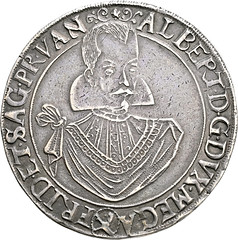
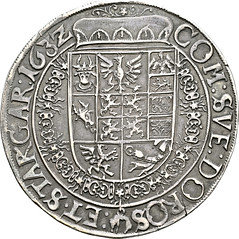
Lot 4065. Mecklenburg. Albrecht Wenzel Eusebius von Waldstein (Wallenstein), Herzog von Mecklenburg und Fürst von Sagan. Reichstaler 1632, Jitschin. Schöne Patina Sehr schön

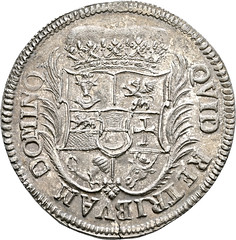
Lot 4068. Mecklenburg-Güstrow. Gustav Adolph, Reichstaler 1677, Güstrow. Äußerst selten Vorzüglich/Stempelglanz
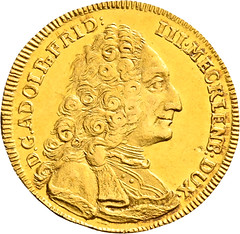

Lot 4113. Mecklenburg-Strelitz. Adolph Friedrich III., Dukat 1717 (geprägt 1745/1746), auf die 200-Jahrfeier der Reformation. GOLD Sehr selten Vorzüglich/Stempelglanz


Lot 4166. Mecklenburg-Strelitz. Adolph Friedrich IV., 5 Taler (Pistole) 1754, Neustrelitz. GOLD Äußerst selten Fast vorzüglich

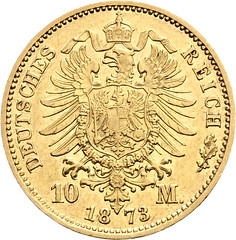
Lot 4261. Mecklenburg-Strelitz. Friedrich Wilhelm, 1860-1904 10 Mark 1873. J. 235. Sehr selten Fast vorzüglich
Auction 441: The Hermann-Joseph Lückger Collection - Rhineland and Westphalia
Or: why Cologne once again?
Exactly one year ago, Dr. Busso Peus Nachf. was fortunate enough to auction the largest collection of Cologne coins and medals of recent decades, the Dr. Jürgen Baur Collection. Now, with the Lückger Collection, it is offering a similar but fundamentally different collection on the subject of the Rhineland and Westphalia. However, it is not a mere 2nd edition to please the underbidders of last time, but an excellent addition to it. The focus of the Lückger Collection is on coins from the Middle Ages and, it can be said, is unparalleled in its size. The times made it possible for well-connected, passionate and affluent collectors to assemble collections of a quantity and quality that is almost unimaginable today. The Baur Collection focused on the city and archbishopric of Cologne, including its dynastic and political contexts. In doing so, it partly left geographical proximity behind. Lückger's collection, being an outstanding historian and archaeologist, was primarily dedicated to the medieval coinage of Cologne's neighbors in the economic area, so that we find coins from the Netherlands to Hesse, Westphalia to Mainz and Trier in a closed density. It is a collection that also offers many rarities and curiosities to collectors not connected with Cologne. There is not enough space here to list them all; to pick out individual ones would be arbitrary.
But of course, there are also coins and medals from modern times up to the 19th century.
See for yourself in the special catalog, which is also of interest to the academic community.
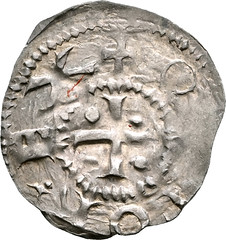
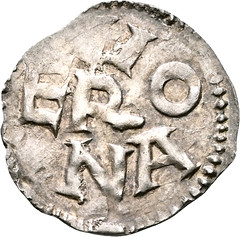
Lot 5088. Bonn, königliche Münzstätte. Otto III., 983-1002, Pfennig vor 996, mit Königstitel. Äußerst selten Sehr schön
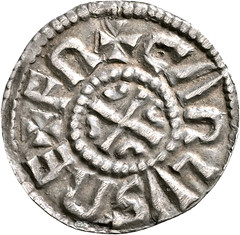
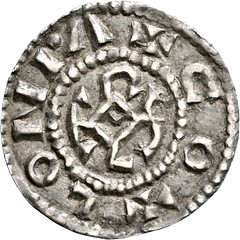
Lot 5174. Köln, königliche Münzstätte. Karl der Große, Pfennig (781/800). Äußerst selten Fast vorzüglich
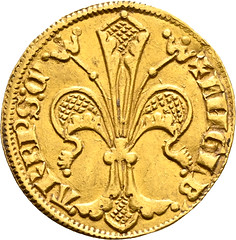

Lot 5416. Köln, Erzbistum. Engelbert von der Mark, Goldgulden o. J. (1364/65), Riel. GOLD Äußerst selten Vorzüglich

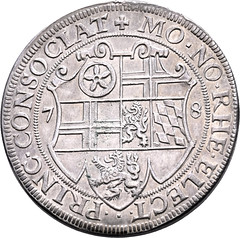
Lot 5537. Köln Erzbistum. Gebhard von Waldburg, Reichstaler 1578, Münzvereinsprägung. Äußerst selten Vorzüglich
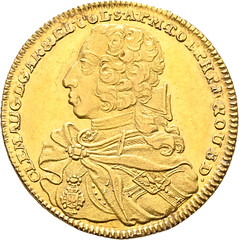

Lot 5574. Köln Erzbistum. Clemens August von Bayern, Karolin 1735, Bonn. GOLD Äußerst selten Vorzüglich
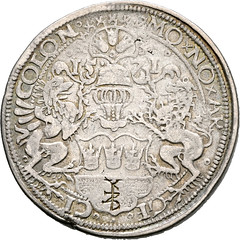

Lot 5611. Köln, Reichsstadt. Dicker Reichstaler 1571, mit Titel Maximilians II., Abschlag von Halbtalerstempeln. Einziges Exemplar im Handel Sehr schön
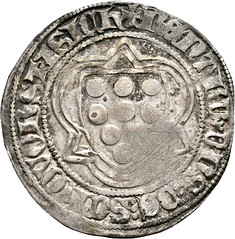

Lot 5766. Schönforst, Herrschaft. Reinhard II., 1369-1396, Herr von Limburg (NL) Turnosgroschen 1392. Äußerst selten Sehr schön
SEDWICK TREASURE AUCTION 36
Sedwick & Associates will be holding their Treasure, World, U.S. Coin and Paper Money Auction 36 on November 7 and 8, 2024. Here's the announcement. -Garrett
This auction is one of our biggest to date, with many important rarities in coins, currency, and artifacts!
In our Gold Cobs section you will find such trophies as a Seville, Spain, 1681/0/79 S gold cob 8 escudos graded NGC MS 61 (Lot 23) and the finest known Seville, Spain, 1659 (R) gold cob 8 escudos graded NGC MS 63 (Lot 17). Also note a lovely Lima, Peru, 1748 R gold cob 8 escudos graded NGC MS 63 (Lot 37).
Shipwreck Ingots hosts one of the finest selections of shipwreck gold bars that we've had so far, with several unique gold ingots from the "Golden Fleece" wreck, the Atocha, the 1715 Fleet, the Luz, and the "Nanking Cargo" (Lots 73-77). Four large silver bars from the Atocha in this sale make a veritable grade set with Class Factors 0.7 up to the perfect 1.0 available for bidding (Lots 82-85).
A new feature in Shipwreck Coins is that gold cobs are now included with their respective wrecks. The Silver Banks Collection hosts over 60 silver cobs recovered from the Concepción by Captain Tracy Bowden (Lots 132-195). There's an incredible selection of Capitana and Maravillas cobs from the Luis R. Ponte Collection including numerous countermarked pre-1652 shield-type 8 reales along with transitional and post-transitional types. The popular 1715 Fleet features a strong assortment of high-grade gold cobs including a fantastic Mexico City, Mexico, 1715 J cob 8 escudos graded NGC AU 58 (Lot 296) and the spectacularly rare Cuzco, Peru, 1698 M cob 1 escudo graded NGC AU 58 (Lot 311). A selection of U.S. shipwreck coins from the S.S. New York, S.S. Central America, and the S.S. Republic are up for sale including a rare San Francisco Assay Office gold $10 graded PCGS XF45 recovered from the S.S. Central America (Lot 424).
Mexico Silver Cobs has a small but nice group of rare "Early" and "Late" Series Charles-Joanna reales (Lots 448-451). Within Lima Silver Cobs, there are several Philip II rarities including a 4 reales of Assayer Rincón plated in Grunthal-Sellschopp's The Coinage of Peru (Lot 457) along with many more choice pieces pedigreed to the Luis R. Ponte Collection.
Our robust Potosí Silver Cobs section features more key coins from the Luis R. Ponte Collection including a Philip II cob 8 reales of assayer L (1st period) with denomination o-VIII over P-M to right, a rarity also plated in Grunthal-Sellschopp (Lot 518). A number of very rare Royals from the Potosí Mint are being offered: Watch for the finest known 1704/3 Y cob 8 reales Royal graded NGC AU 55 (Lot 654) and the extremely rare 1709 Y cob 8 reales Heart ex-von Schuckmann (Lot 655) in this section.


Lot 1282. JAMAICA, British Administration, gold 5 pounds, GR countermark (1758) on a Lima, Peru, bust 8 escudo
Several very important collections are featured in World Coins including the Jorge Becerra Collection of Colombian Colonial Coins, the JEAS Collection of Gold Coins of Independent Colombia, Part I of the Emilio M. Ortiz Collection of Gold Coins, and Part I of the John M. O'Brien Reference Collection of Peruvian Coins. Collectors of classic Chinese coin rarities should watch for Lots 870 through 911 for numerous vintage Chinese coins from the imperial and republican eras with particular highlights being the eye-appealing Tsao-Kun military attire silver dollar of 1923 graded PCGS MS 64 (Lot 906) and the ever-popular Kweichow Year 17 (1928) "Auto" dollar graded PCGS VF 30 (Lot 909). A key coin in this session is the rare Jamaica GR countermarked of 1758 on a Lima, Peru, gold bust 8 escudos of 1751 J graded NGC c/s AU strong pedigreed to the Farouk and Rudman collections (Lot 1282). Spanish gold milled 8 escudos are well represented with several finest known and "top pop" pieces up for bidding including the gorgeous and finest known Seville, Spain, 1714 M gold 8 escudos graded NGC MS 65 (Lot 1429). Chile is another very strong area in this sale with many Spanish colonial and Republic gold and silver types available for the expert collector including the very rare Coquimbo 1828 TH "volcano" peso graded NGC AU 50 (Lot 830).
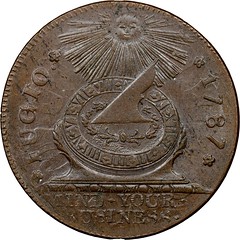
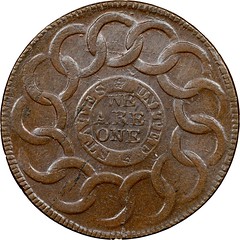
Lot 1500. UNITED STATES, Philadelphia mint, copper Fugio cent, 1787, four cinquefoils, pointed rays, STATES UNITED
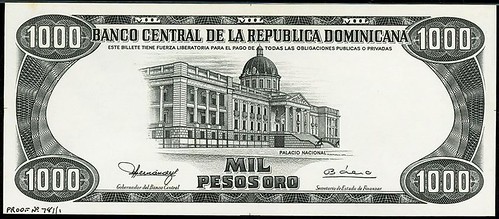
Lot 1536. DOMINICAN REPUBLIC, set of five progressive proofs (5, 10, 50, 500, and 1000 pesos oro), (1978-82)
The curated Medals and Decorations section hosts several tough Bolivian medals and orders including a gold Ingaví millitary decoration of 1841 (Lot 1458). We also present another selection of Admiral Vernon medals from the prestigious John Adams Collection (Lots 1465-1486). Within U.S. Coins, Medals, and Tokens there are several important early American rarities, notably an amazing 1787 Fugio cent graded NGC MS 66 Brown—a lofty "top pop" grade for this historical type (Lot 1500). Other highlights include a 1883-S gold $20 double eagle graded PCGS AU53 from the Saddle Ridge Hoard (Lot 1490) as well as an 1894 gold proof $2 1/2 quarter eagle graded NGC PF 58 (Lot 1491). The U.S. Paper Money section has several tough Obsoletes including two Civil War-era State of Florida notes (Lots 1506 and 1507). World Paper Money hosts many beautiful, high-grade, Latin American specimens and proofs including the finest known Costa Rica Banco Mercantil specimen 20 colones graded PMG Superb Gem UNC 67 EPQ (Lot 1523) and a very rare PMG-graded set of five Dominican Republic progressive proofs from 1978-1982 (Lot 1536).
The fifth session of our sale starts with Ancient and Medieval coins with many popular Ancient Greek, Roman, and Byzantine designs, including a beautifully toned Imperial Roman silver "elephant" denarius of Julius Caesar (Lot 1561) and a lustrous NGC-graded Mint State Byzantine Empire gold solidus of Justinian II (Lot 1565). Following that, the popular Coin Jewelry section hosts many gold and silver shipwreck, Spanish colonial, and ancient coins mounted into settings and ready for wearing.
This auction has a very strong Shipwreck Artifacts section featuring many pieces from the Concepción salvage work done by Captain Tracy Bowden as well as pieces he recovered from Bannister's pirate ship Golden Fleece sunk off the Dominican Republic in 1686—an historic first offering of a new pirate shipwreck!—in addition to items from the Guadalupe and Tolosa of 1724. The Non-Wreck Artifacts section holds an array of fossils (Lots 1640-1650) as well as historical items like a sword presented in 1856 to Heinrich Halfeld for engineering work in Minas Gerais, Brazil (Lot 1654). We close out the sale with the online-only Express session featuring over 400 lots from all categories.
We wish you all good luck and hope you find the next great treasures for your collection in this sale!
Event Summary:
Start Date: Wednesday, November 6, 2024 (Lot viewing and educations talks)
Educational Talks:
2:00 – 2:45 PM: Jorge Becerra Leon (Bogotá,) – "Colonial Colombian Coins"
3:00 – 3:45 PM: Jorge Ugaz (Lima,) – "The Cob Coinage of El Peru" (Spanish)
4:00 – 4:45 PM: Ignacio Gutierrez (Madrid) – "Los Doblones de a Ocho"
5:00 – 5:45 PM: Emilio M. Ortiz (Puerto Rico,) – "Gold Coinage of The Caribbean"
6:00 – 6:20 PM: Charlie Winn – (Representing The 1715 Fleet Society)
6:45 – 8:00 PM: Invitation-only cocktail reception at SpringHill Suites.
SOVEREIGN RARITIES WORKMAN COLLECTION, PART 2
Here's an additional announcement from Sovereign Rarities with selections from the Bernard Workman Collection of Bronze Penny Rarities, and more. -Editor
Sovereign Rarities of London UK are proud to present for auction on the afternoon of November 19th 2024 the Bernard Workman Collection of Bronze Penny Rarities 1860-1967 – a scintillating selection of forty of the most elusive pennies from the reigns of Queen Victoria to Queen Elizabeth II, including the only example in private ownership of the Edward VIII trial reverse with the modern dreadnought class battleship by Britannia that has never been auctioned before.
With the advent of the reign of King Edward VIII the question of coinage was in gestation for a very long period from this modern thinking King, who wanted to revise nearly all the reverse designs on silver and bronze coinage, introduce a new twelve sided brass Threepence coin, and more controversially wished to face left on his coins like his Father, breaking a long held tradition since the time of the Stuarts for each succeeding monarch to face the opposite direction to their predecessor. However, a currency coinage never came to fruition due to the King abdicating for the love of the American divorcee Wallace Warfield-Simpson in December of 1936 (now a year of three Kings not seen since 1066) in favour of his younger brother who became King George VI (1936-52). Luckily for the delight of numismatists, there were some complete proof sets of coinage from gold Five Pounds to the bronze Farthing which do exist, one being held privately in the Tyrant collection, that show all the new designs that were modern for their time, including the Penny. The 1937 Proof Penny of Edward VIII has a design with the sea to the right of Britannia unhindered by any ship, and this adopted reverse design progresses unchanged into the reign of George VI for his proof set of 1937 and the ongoing currency. Before that and whilst the new proposed designs were in gestation during 1936, one of the more interesting earlier proposals for a Penny reverse design was this coin which depicts a modern armoured battleship sailing bow towards viewer, on the sea to right of Britannia. This proposed design with a battleship harks back to the Victorian bun head bronze pennies which feature a sailing cutter in this position, but presumably after consideration was eventually dropped as a proposal as this "Dreadnought" class of ship was an instrument of war having been used in World War I at what would have been a sensitive time in Germanic relations and the run up to World War II.
This Pattern Penny although described as uniface in fact features a continuous linear spiral from centre to rim on the obverse side and is listed in Giordano's "Portraits of a Prince" publication on Edward VIII as one of two known. A plaster impression of this reverse is in the Royal Mint museum. This coin was purchased by Bernard Workman privately some ten years ago, his most recent purchase, and had been held in a private collection since the mid-1990s. It has never crossed the auction bloc before and is perhaps conservatively estimated at £10,000-£15,000 housed in an MS65BN NGC holder.
Moving back to Edward VIII's Father George V we find this major coveted rarity, seemingly the finest known 1922 currency Penny that carries the later 1927 onward style reverse. This is a classic rarity in the George V series and apart from the unique 1954 and 1933 Pennies, is the rarest currency pre-decimal Penny of the 20th century. The obverse is the same as regular pennies of 1922 and before and it is the reverse that differs. There are a number of subtle differences but the most obvious to spot especially as most of the very rare survivors or in circulated worn state is where Britannia's hand grasps onto the shield. We see a different arrangement of finger and thumb compared to earlier pennies. The sea is also more finely cut in its ripple and wave detail, most noticeable to the right of Britannia. Graded by NGC as AU53 brown this coin is presumably the top of the population and maybe the only graded example with a straight grade, extremely rare this currency Penny is estimated to sell for £5,000-£6,000 on November 19th.
This week we opened with the story of the battleship trial piece of Edward VIII, as we are on this maritime subject we must highlight this Pattern Penny which has a two masted sailing ship in full sail to the right of Britannia. The newer style "widow" head Pennies of Queen Victoria in an older phase of life were introduced as currency from 1893 with a veiled portrait facing left by Thomas Brock and we see a few alternative reverse designs being proposed for the following couple of years including this piece. Superbly rendered, the large sailing ship is quite dominating in the space to the right of Britannia, harking back to the earlier "bun head" design pennies that have a smaller sailing ship in the distance to the viewer. This larger ship was perhaps considered to overbearing to contemplate a change of design to currency and remains an extremely rare pattern piece hardly ever seen for sale and it has a wonderful provenance chain dating back to the Nobleman Collection in 1922. This is followed by the names Egmont Schmidt, C. Wilson Peck and Michael Freeman, the latter two being authors of their own standard works on the subject of these coinages. With a proof finish the coin has been graded by NGC as PF65 brown with an estimate of £6,000-£8,000 for November 19th 2024.
In last week's E-Sylum we highlighted one of the Heaton mint Pennies of 1874 for auction on November 19th. For the year 1882 the vast majority of Bronze Pennies are usually also of the Heaton mint variety with the tiny letter H below the two 8s of the date. However, there are some extremely rare, usually low grade survivors of what must have been a very small London issue of 1882 dated pennies. These London mint issues also carry a different die combination to the Heaton pieces to prove their origin and are not determined just on the lack of the H mint mark. The London issue has a finer arrangement of border teeth than Heaton, a more hooked nose with a weaker bridge and some raised leaf veins in the 15 leaf wreath. The reverse has an overall thinner Britannia and a thinner trident shaft than the Heaton production, as well as the lack of mint mark. This coin definition wise is one of the best survivors of this London production and is toned, however NGC have deemed it to have been cleaned, but such a rarity will no doubt garner a lot of bids on the attractive estimate of only £2,000-£3,000 on November 19th.
Going back one year we have the rarest Heaton Mint Penny of 1881 due to its die combination. Struck in Birmingham, this coin carries the H mint mark under the two 8s of the date and has been classified by Michael Freeman as number 103 which is obverse die 9 and reverse die M. This means the obverse has a 17 leaf laurel wreath with incuse veins and 6 berries, and the Queen has a more deeply engraved nostril. The reverse die has a heraldically shaded shield and a thicker lighthouse as well as the H mint mark below the date. The coin does have some light circulation weak with some surface marks and NGC in their wisdom have deemed this coin to be details cleaned. However with a Freeman rating of R19 out of 20 points for rarity it is estimated at £1,200-£1,800 for the November auction.
In last week's E-Sylum we covered the 1863 die number Pennies of which numbers 2, 3, 4 and 5 are known, all with slim survival and here we feature the die number 4 piece with the tiny number below the 8 and 6 of the date. All part of an experiment to trace the use of the dies by an operator and subsequent output. Though the coin is toned with wear from circulation NGC have deemed it as cleaned but as such a rare survivor with this number 4 it is fairly estimated at £3,000-£4,000 for the 19th November auction.
Seemingly the greatest currency rarity for the date 1863 is this Penny with a more slender thinner 3 in date than usual and still one of only two examples known, this being the first one discovered and once part of the Michael Freeman and H. Samuel collections where it only was offered as part of larger lot groups of pennies for sale. Once the second example was discovered in just as well circulated condition, that coin sold at a London auction 15 years ago for an amazing £19,000 hammer after a strenuous bidding battle on a much lower estimation. This coin in the Bernie Workman collection was purchased by him from the Samuel Collection in 1995 and is housed in a "environmental damage" NGC holder which is fair considering the overall preservation of this rare piece. The date variety is most clear and as one of two known estimated at £2,000-£3,000 for November 19th.
For last week's E-Sylum we highlighted the cupro-nickel pattern of 1870 with the same design as this piece. This coin is one of five patterns all of the same design and is from the earliest date of 1862 and in the off metal of nickel brass. The obverse design was by T. J. Minton who took over as Resident Engraver in 1865 and was the last person to hold this post, after the previous holder George Wyon died in 1862. The design was modelled on a portrait by sculptor W. Theed who was a designer for Wedgewood. The coronet head obverse was not subsequently used on British coinage but a derivative was used on some colonial coinages for Malta, British Honduras and the Strait Settlements. This nickel brass piece is of the highest rarity, graded by NGC as PF65 and estimated to sell for £6,000-£8,000. There are also bronze versions of this pattern dated 1862, 1865 and 1870 in the Bernard Workman collection.
The second of three overdate coins in the offering of Pennies from the Bernard Workman Collection is the finest graded 1861 with the 8 struck over a 6 in the date. With the grade so high as MS65 red and brown this coin is actually amongst the finest of the population of the regular date currency pennies, nevermind the fact it is the extremely rare overdate. Therefore on November 19th this coin is estimated to sell at £6,000-£8,000
Other Property:
Aside from the Bernard Workman Collection of Pennies in the Sovereign Rarities Auction 16 of the 19th November there are some other great British coins as well as this highly valuable rarity struck from Australian gold at the Melbourne Mint in 1900.
This superbly preserved gold Proof Sovereign of the year 1900 from Melbourne is thought to be one of only two examples that exist and is the only one graded. This coin has been through Australian auctions on at least four occasions dating back to the 1980s and is rumoured to have once been part of the A. H. F. Baldwin Collection and possibly J. G. Murdoch. The coin is a superb example of any proof Sovereign, and it is nice it features the turn of the century date. Estimated at £50,000-£60,000 it will be sold in the general part of our sale on the afternoon of 19th November.
For more information, see:
https://www.sovr.co.uk/
To read the earlier E-Sylum article, see:
SOVEREIGN RARITIES WORKMAN COLLECTION
(https://www.coinbooks.org/v27/esylum_v27n42a21.html)
THE CHEW VALLEY HOARD
Michael Kodysz passed along this Guardian article about a coin hoard to be displayed at the British Museum next month. The story soon went viral and was reported in multiple outlets. Thanks also to Aaron Oppenheim, Bill Rosenblum and Arthur Shippee. Great find. -Editor
It began with a speculative trip to a soggy field in south-west England by a seven-strong band of metal detectorists more intent on figuring out how to use some new kit rather than unearthing anything of great historical importance.
But the friends came upon an astonishing hoard of coins – 2,584 silver pennies – from the time of the Norman conquest, which has been valued at £4.3m, making it the highest-value treasure find ever in England.
On Tuesday, the charity South West Heritage Trust announced it had acquired the coins for the nation thanks to major funding including from the National Lottery Heritage Fund and Art Fund.
From 26 November, the hoard will go on display at the British Museum in London and will then be shown across the UK, including Bath, not far from the spot it was found, before finding a permanent home at the Museum of Somerset in Taunton.
South West Heritage Trust described the hoard as one of the most remarkable ever found. It said it came from a turning point in English history, a time of transition from Saxon to Norman rule just after the Battle of Hastings, and was probably deposited for safekeeping during rebellions in the south-west against William I.
Represented on just under half the coins is Harold II, the last crowned Saxon king of England, while just over half feature William I. The number of Harold II coins is double the number that have ever previously found and increases by nearly fivefold the number of known coins of William I issued in the two years after his coronation in 1066.
About 100 moneyers – the person in charge of producing coins – from 46 mints including Bath, Bristol, Exeter, Hastings, Ipswich, London and York are represented. The coins of Harold II are mainly from mints in south-east England, perhaps suggesting financial preparation for the Norman invasion.
To read the complete article, see:
Coin trove from time of Norman conquest becomes England's highest-value find
(https://www.theguardian.com/culture/2024/oct/22/coin-trove-from-time-of-norman-conquest-becomes-englands-highest-value-find?)
To read the other articles, see:
Hoard of silver coins dating from Norman Conquest is Britain's most valuable treasure find ever
(https://www.cnn.com/2024/10/22/science/norman-coins-most-valuable-find-britain-intl-scli/index.html)
How 7 Friends Testing a Metal Detector Made Britain's Most Valuable Treasure Find
(https://www.nytimes.com/2024/10/24/us/chew-valley-hoard.html)
950-year-old coins unearthed by treasure hunters are U.K.'s highest-value find
(https://www.washingtonpost.com/world/2024/10/22/norman-coins-hoard-sold-uk-most-valuable-treasure/)
BIDEN AWARDS NATIONAL ARTS MEDALS
President Biden presided over an emotional National Arts and Humanities Medal ceremonies in the East Room of the White House this week. Filmmakers and performers present included Steven Spielberg, LeVar Burton, Spike Lee, Queen Latifah. -Editor
Joe Biden got several standing ovations as he presented the National Medals of Arts and Humanities, including a moment when he referenced the presidential race as he talked about the power of women.
"I know the power of women to get things done, and also help the next generation of pioneers, proving a woman can do anything a man can do and then some. That includes being president of the United States of America."
The remark drew large cheers and a standing ovation from the audience in the East Room, where Biden was joined by First Lady Jill Biden, National Endowment for the Arts chair Maria Rosario Jackson and National Endowment for the Humanities chair Shelly C. Lowe.
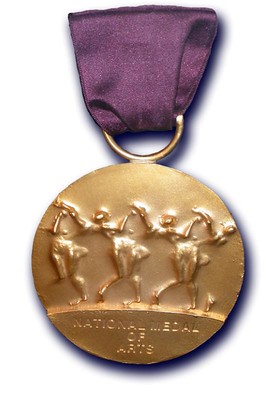 Among the recipients present were Steven Spielberg, LeVar Burton, Spike Lee, Missy Elliott, Queen Latifah, Idina Menzel, Jon Meacham. Aaron Sorkin and Bruce Cohen.
Among the recipients present were Steven Spielberg, LeVar Burton, Spike Lee, Missy Elliott, Queen Latifah, Idina Menzel, Jon Meacham. Aaron Sorkin and Bruce Cohen.
There were 39 recipients of the medals at the event, as the White House combined the 2022 and 2023 ceremonies. The honorees already had received their medals by the time of the public ceremony, and instead were introduced at they entered and stood as a group.
Biden choked up a bit as he recounted the story of a 10-year-old Martin Luther King Jr. listening on the radio when singer Marian Anderson performed at the Lincoln Memorial in 1939. Because of her race, she was barred from appearing at the Daughters of the American Revolution hall, so then-First Lady Eleanor Roosevelt had her perform on the steps of the memorial.
Biden spoke of the song that Anderson sang, My Country, Tis of Thee, but he paused and his voice cracked as he uttered the next verse, "sweet land of liberty."
"Twenty five years later, that 10 year old boy stood in those same steps," Biden said. "His name was Martin Luther King Jr. and he declared a dream during the March on Washington. He asked Marian Anderson to perform once again, and she did."
To read the complete article, see:
Joe Gets Big Cheers At National Arts Medal Ceremony For Talking Up A Woman President's Power "To Get Things Done" — Update
(https://deadline.com/2024/10/biden-national-media-of-arts-and-humanities-1236121601/)
For a complete list of recipients, see:
President Biden to Award National Medals of Arts
(https://www.arts.gov/news/press-releases/2024/president-biden-award-national-medals-arts)
2022 and 2023 National Medal of Arts and National Humanities Medal Citations
(https://www.whitehouse.gov/briefing-room/statements-releases/2024/10/24/2022-and-2023-national-medal-of-arts-and-national-humanities-medal-citations/)
JEWISH-AMERICAN MEDAL SERIES REBOOTS
Good news - the Jewish-American Hall of Fame Medal series is back. Here's the announcement. -Editor
Mel Wacks, Director of the Jewish-American Hall of Fame medals recently announced "the best news since we started issuing medals way back in 1969. There is going to be a Jewish-American Hall of Fame medal in 2024! Since we couldn't find a mint that could strike our medals in high quality at a reasonable cost, we turned to Jim Licaretz, who has been producing our plaques for a number of years (that are exhibited at the Virginia Holocaust Museum). Jim has made some wonderful cast medals in recent years, including Volodymyr Zelensky, winner of the prestigious 2023 award for the American Medal of the Year. For the Molly Picon medals, Jim made a 3-D printed model directly from Eugene Daub's plaster-of-paris original; he then cast medals in cold-cast bronze and hand-applied a handsome patina. Jim made over a half dozen different samples before finding the right finish."
The large 3 1/2 inch medal is designed by Eugene Daub, winner of the American Medal of the Year award in 2024. It features a pensive portrait of Molly Picon on the obverse. The reverse celebrates Molly's role in the 1923/4 Yiddish musical "Yonkele," that played at the Second Avenue Theatre. The opening notes to the title song were taken from Picon's own copy of the sheet music, in the collection of the American Jewish Historical Society. No more than 100 Molly Picon medals will be made. They are offered for $160 each by calling 818-225-1348; 50% of the cost can be considered as a tax-deductible contribution to the non-profit Jewish-American Hall of Fame.
Molly Picon (1898-1992) was a star of the Yiddish and American stage and movies, including Come Blow Your Horn, for which she received an Academy Award nomination, and Fiddler on the Roof. She appeared on television in the police comedy Car 54, Where Are You? and in a few episodes of The Facts of Life. Picon's final role was in Cannonball Run in 1984. Molly Picon has a star on the Yiddish Theater Walk of Fame, and was inducted into the American Theatre Hall of Fame in 1981.
To read the earlier E-Sylum article, see:
JEWISH-AMERICAN HALL OF FAME MEDALS END
(https://www.coinbooks.org/v27/esylum_v27n22a24.html)
2025 MADISON COUNTY COIN CLUB MEDAL
Harold Fears of the Madison County Coin Club passed along this information about the club's new medal. -Editor
The Madison County Coin Club of Huntsville, Alabama, is issuing a 2025 club medal. Daniel Carr, proprietor of the Moonlight Mint of Loveland, Colorado, will produce the piece. The main motifs mimic Bela Lyon Pratt's half eagle (gold $5) design, with additional obverse and reverse inscriptions around the rim that read MADISON COUNTY COIN CLUB / HUNTSVILLE ALABAMA and EDUCATION * PUBLIC SERVICE * FELLOWSHIP / FOUNDED 2001, respectively.
The medals will be available in silver for $100 and copper for $15. The silver has a mintage limit of 40 and the copper is 60. Please note that earlier, 20 silver and copper medals were reserved by club members as part of three-medal member only set, which contained an additional brass medal.
If you are interested in acquiring these medals, send an email to newsletter@mccc.anaclubs.org. All proceeds from the sale of the 2025 medals will go directly to the Madison County Coin Club. For more information about the club and this medal, visit the club's website. You do not have to be a member of the club to purchase a medal.
THE NEW BRICS FANTASY NOTE
Kavan Ratnatunga passed along articles about the new BRICS Fantasy Note - thanks. -Editor
At the same time, today on the sidelines of the forum, an episode, although humorous, but very symbolic for the US and its European satellites, took place. Russian President Vladimir Putin was shown a "BRICS banknote".
What is characteristic is that the banknote depicts the flags of not only the direct members of the Commonwealth, but also other states, including Kazakhstan and Afghanistan.
The Russian leader looked at the joke banknote, smiled and handed it to the ministers. Later, the Kremlin press secretary told journalists that the banknote was handed to the president by someone from the Russian delegation. He added that the latter points to the common work being done within the framework of the commonwealth.
It is worth noting that this is precisely the symbolism for the West. Firstly, it has been repeatedly stated that the BRICS banks are working on creating their own payment system, independent of the dollar. Secondly, the abundance of flags on the joke banknote hints at the fact that the commonwealth will steadily expand.
It is reported that the head of the Central Bank of the Russian Federation, Elvira Nabiullina, did not like the banknote.
To read the complete articles, see:
At the summit in Kazan, the Russian president was shown a symbolic "BRICS banknote"
(https://en.topwar.ru/252487-na-sammite-v-kazani-prezidentu-rf-pokazali-simvolicheskuju-kupjuru-briks.html)
BRICS Currency Unveiled A New Era in Global Finance
(https://www.financial-news.co.uk/brics-currency-unveiled-a-new-era-in-global-finance/)
FEATURED WEBSITE: COIN PHOTOGRAPHY STUDIO
This week's Featured Website is Canadian Denis Richard's Coin Photography Studio. His Coin Blog has some nice articles we'll be republishing with permission in future issues. There's also a fabulous compilation of artwork incorporating coins "featured in paintings by celebrated artists from Rembrandt to Rockwell." Check it out.




